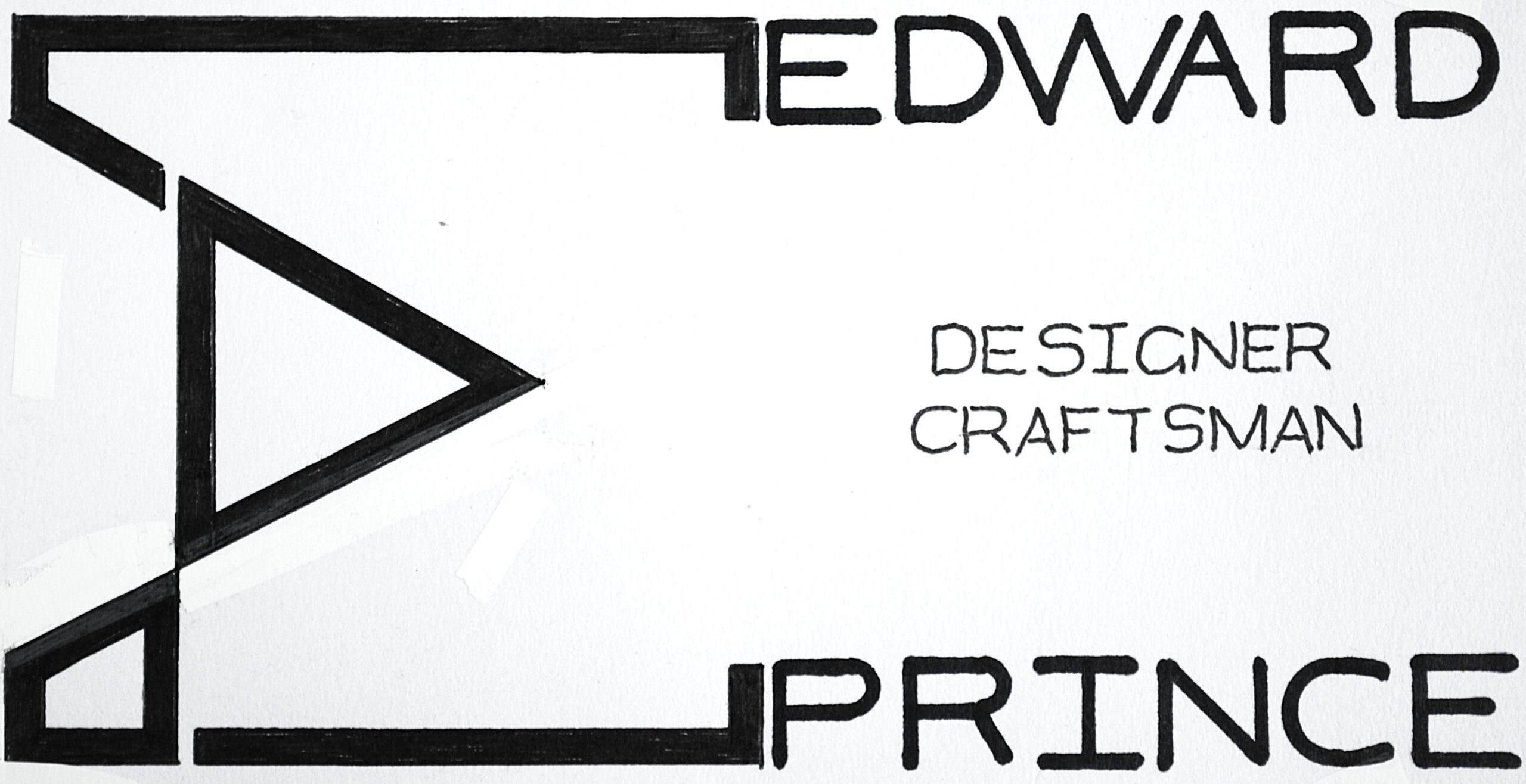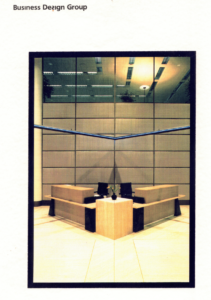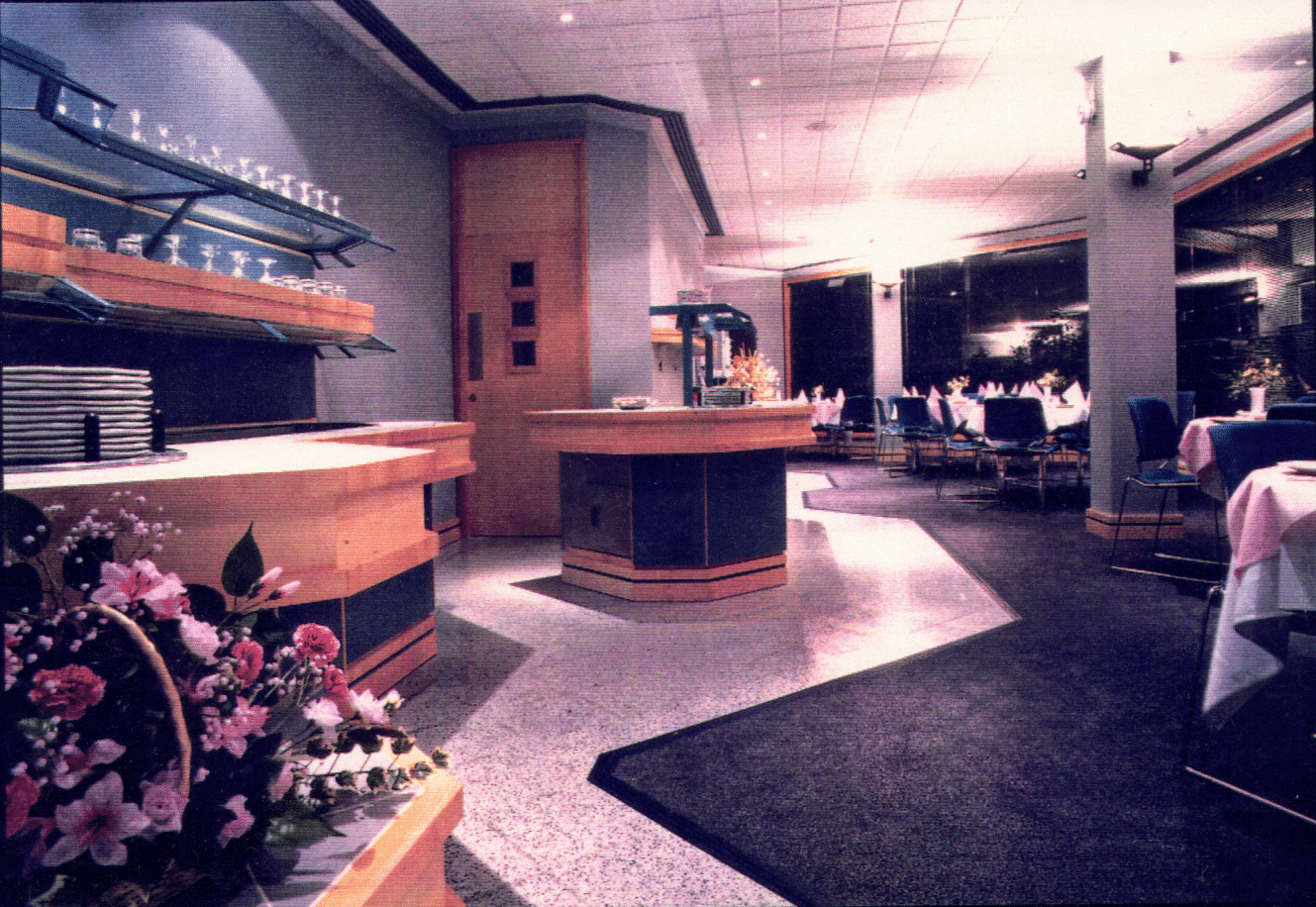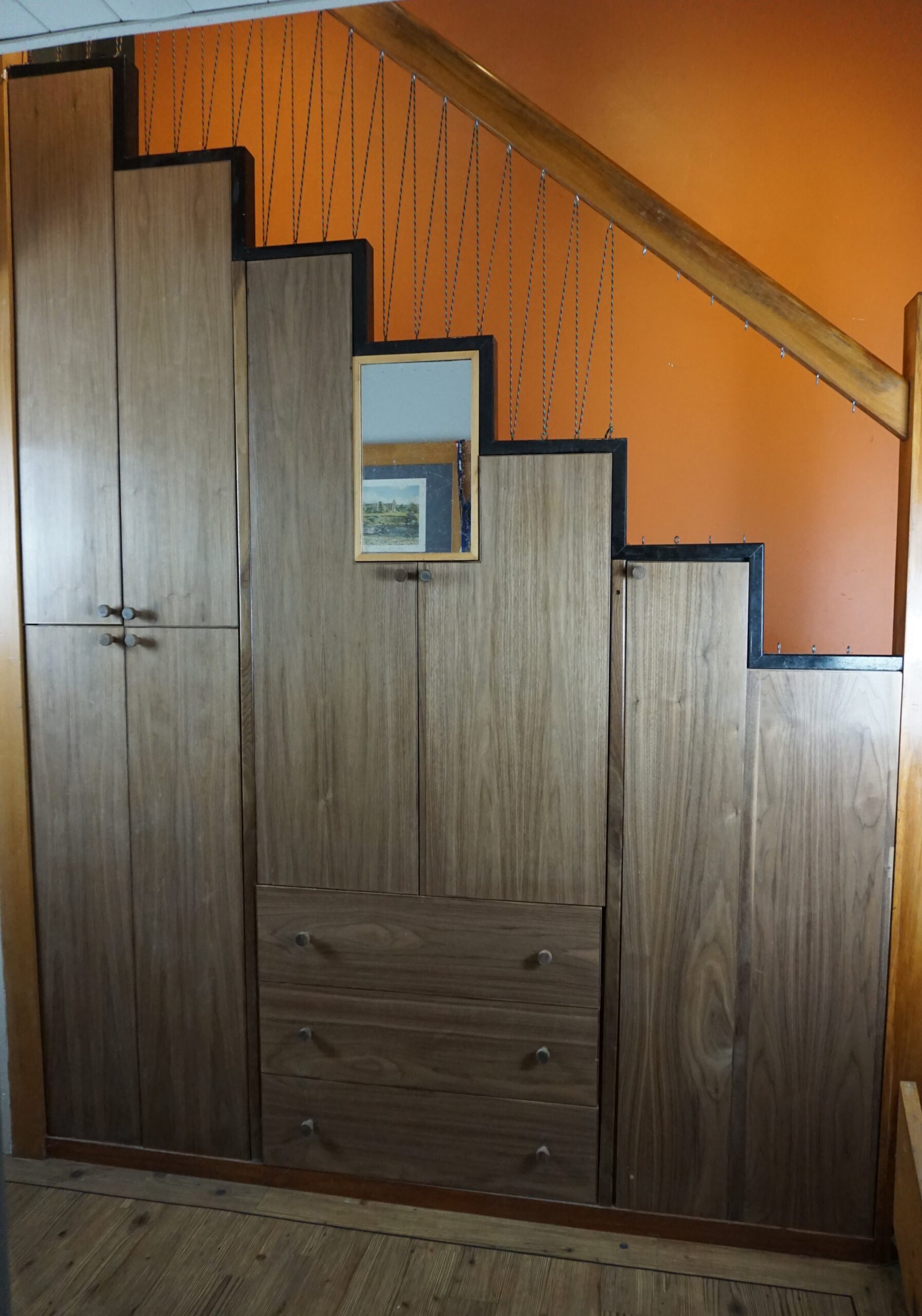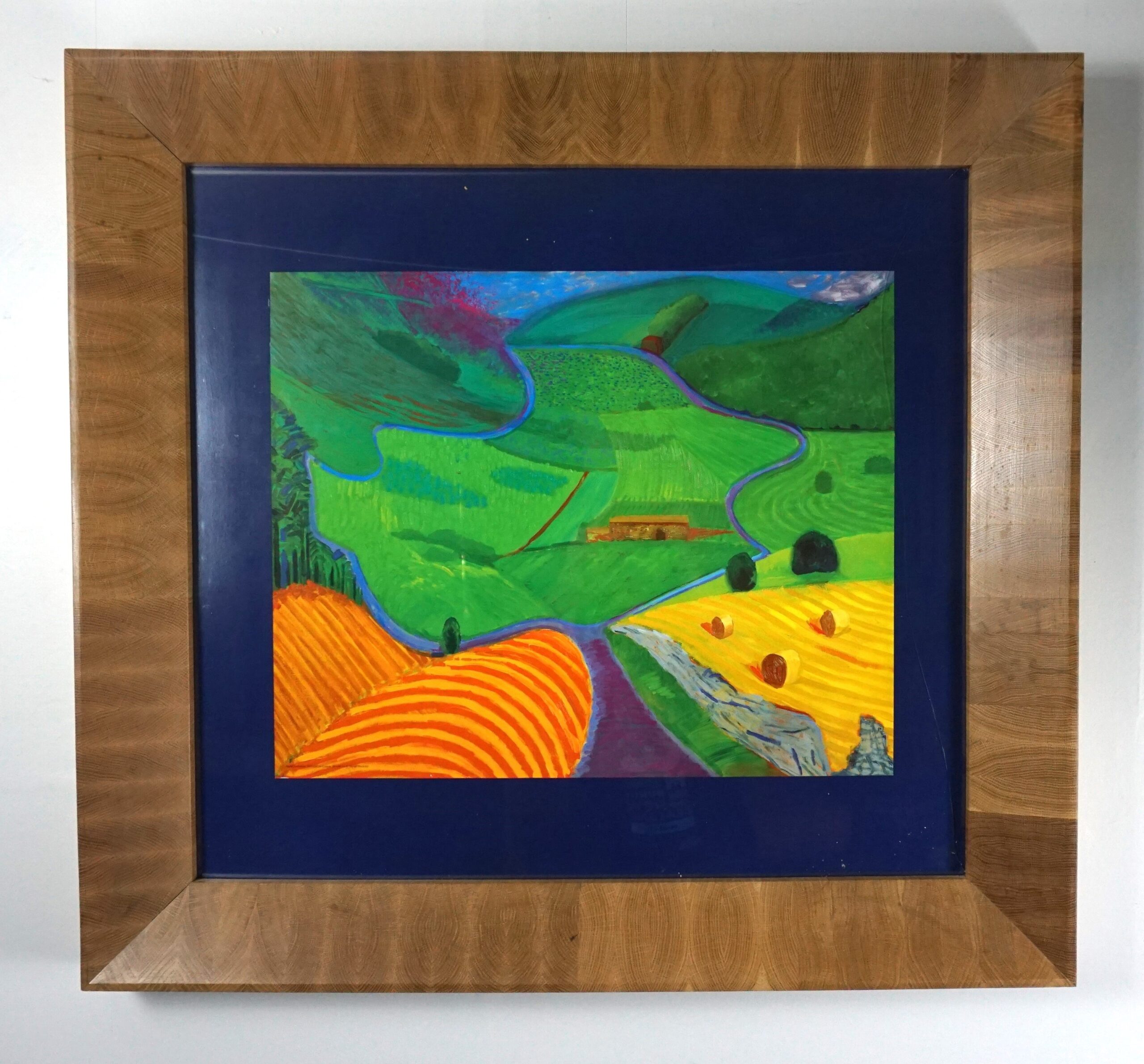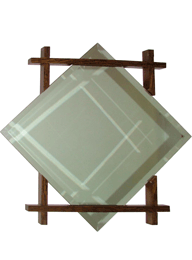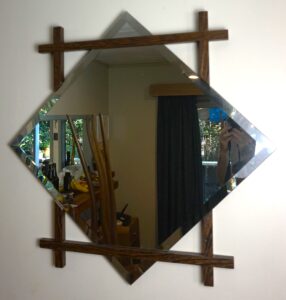The following pages are an introduction into the fascinating subject of creativity. The essays are edited from my Master in Design Management thesis which asks the question “How can we be more creative?” The conclusion being – there are lots of different ways. The first step being to believe that you are creative closely followed by developing multiple-awareness’s combined with a range of tools and strategies. Finally exist in a creative culture where innovation is encouraged. I hope you find something interesting with which you can put into practice.
Author: Edward Prince
-
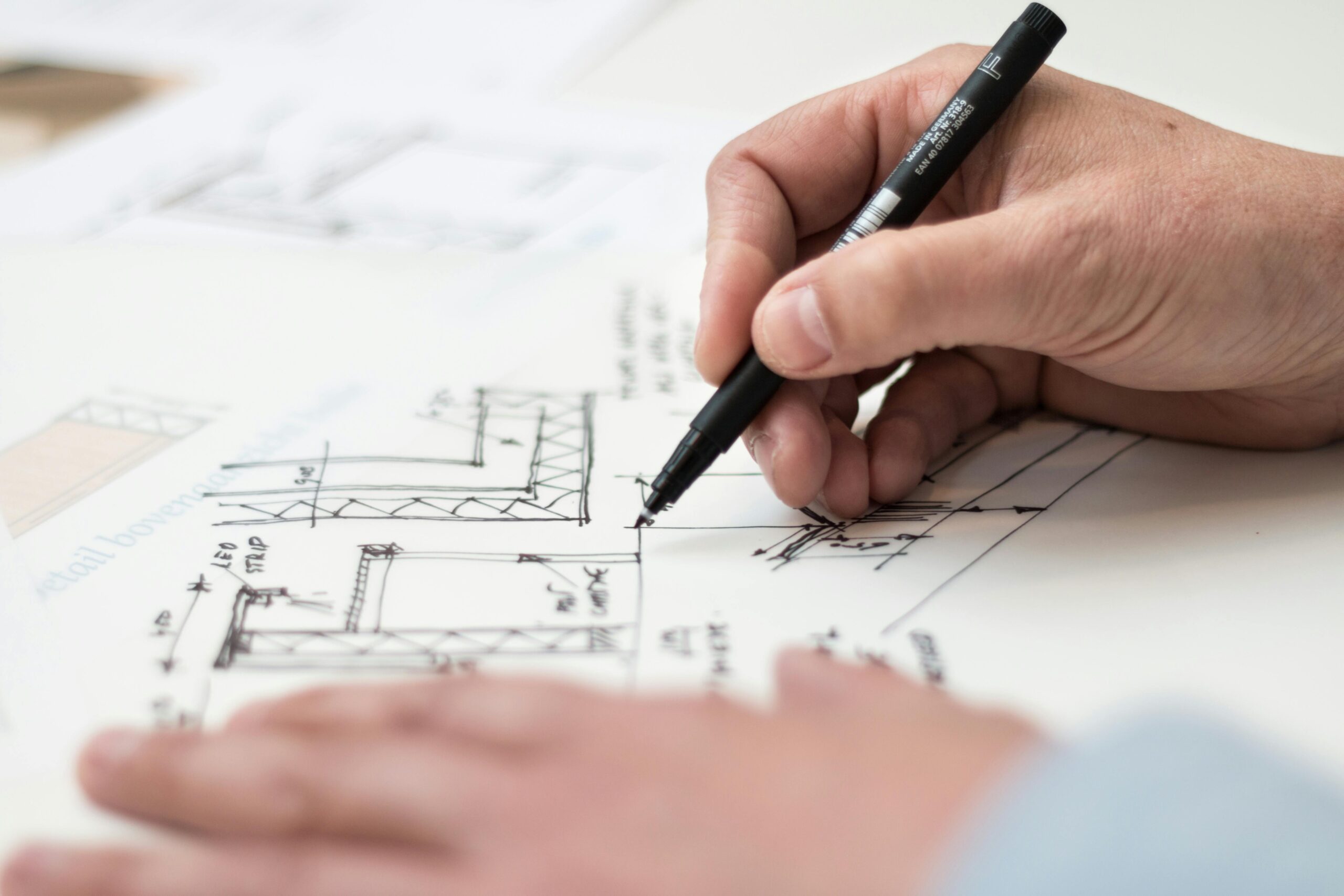
What is Creativity
Creativity and innovation are currently enjoying great popularity as the trend of the moment we are urged to be more creative because this will create economic prosperity and competitive advantage. All this talk of creativity and innovation sounds great, “Yes I want some of that” we think. Only to find we are presented with meaningless academic waffle and unhelpful theories requiring considerable additional research to turn into useful tools. It is the intension in this series of articles to present a few basic ideas that can be used to help us access higher levels of personal and organisational creativity.
Creative types as designers are as well as others in the arts like film, theatre, music are often thought by the general population as inhabiting the heart of creativity and it is to those individuals that we turn when looking for creativity. Creative individuals frequently play upon this through dress and behaviour and leave others feeling that they are not creative. This self belief in either being creative or not creative is one important key to accessing individual creativity. This assumption is incorrect because every person is creative to a greater or lesser degree irrespective of their occupation or personality. The history of mankind abounds with examples of creativity whether in science, business or the arts. As it is through the universal desire to create that we have arrived in the 21st century with the economics, cities, technology and leisure activities we all enjoy.
Humanist psychologists agree creativity is a response to basic inner needs in people under a broader hierarchy. They maintain that people create in order to grow and fulfill themselves, as well as to solve conflicts and answer the cravings of the ID. This is explained by Carl Rogers, “The mainspring of creativity appears to be …man’s tendency to actualise himself, to become his potentialities… the urge to expand, extend, develop, mature… The tendency to express and activate all the capacities of the organism, to the extent that such activation enhances the organism or the self. This tendency may become deeply buried under layer after layer of encrusted psychological defenses. It may be hidden behind elaborate facades, which deny its existence. It is my belief, however, based upon my experience, that it exists in every individual and awaits only the proper conditions to be released and expressed”.
The following conclusions can be drawn about the basis of creativity:
Man creates for reasons of inner drive, whether it is for purposes of conflict resolution, self-fulfilment or both. He can of course create for other reasons such as money, status.
Some elements of creativity occur in a part of the mind, below the conscious level.
Although creativity and neuroses may stem from the same source, creativity tends to flow best in the absence of neuroses.
The conscious mind or ego is a control valve on creativity.
Creativity can create anxieties”.
If we take a step back from the notions of creativity in popular culture we will soon see that the essential creativity of human beings runs throughout history and culture. Something about our human nature is such that creativity lies at the heart of what we are all about. A creative urge motivate most of our lives. Whether this is through a child’s first painting or an adults desire to decorate both ourselves or our homes. At a basic level we recognise that there is something creative in meeting any challenge presented to us through relationships or a new path, these activities cause us to grow and create something within us. When these desires are not me we invent new challenges like sport and games. They are all a seep need to be creative.
Important scientific developments in the last few decades show that some of the creativity we associate with ourselves extends, in an elementary way to all life. Through an order that extends from routine to chaos. The creativity of living systems arises from their ability to create the kind of order that gives rise to systems that are greater than the sum of their parts. It is the capacity of all living systems to spontaneously make ordered, relational wholes the basis of all creativity.
When a designer begins their project energy is pumped into the brain and alters its quantum state. As the brains wave state changes both ideas and beauty emerge from the myriad of options stored gained from life experience. The whole process is one of free decisions made in dialogue with the environment, combined with the creative discovery of the potential person within the designer; self-awareness, the environment and connections. Through the process of creation the person can discover something of themselves. These ideas are core to art, music and drama therapy. Human creativity comes from a living system that is highly complex and has the capacity for rational analysis and self reflection. It is the joint capacity to bring our world and ourselves into being through a shared creative response combined with creative self reflection that gives us the elaborate creativity which accounts for the human world.
These ideas give us a very good indication of some very important elements in developing ourselves as creative individuals, these being.
- The necessity to become self reflective and understand what makes us tick. developing the ability to identify why certain ideas have or have not worked and what we can do to improve these successes or failures. Through becoming self reflective we develop our consciousness and realise the extent to which we are blind to so many different things.
- Adopting the concepts of the quantum self, this involves what many consider to be the key to creativity. “Connecting things”, by finding a common theme, analogy, metaphor or combination between two separate ideas a new idea is created.
- Using the environment both as a conscious form of stimulation and also arranging the physical environment to stimulate both the senses and the subconscious.
-

The Creative Process
Creativity and problem solving are not different things, creativity is a problem solving process. Creativity begins when you are inspired to tackle a challenge. It evolves into your breakthrough idea for meeting the challenge and ends when you implement the idea. The whole process being the process of innovation.
The creative problem solving process is divided into three distinct phases that includes five to eight steps. The first stage, understanding the problem will determine a clear and effective picture of the area of concern, this is divided into three stages, mess finding, data finding and problem finding. The second phase, idea generation is where many new or unusual ideas are formed. The final stage is planning for action in which the ideas are evaluated and promising ideas are translated into acceptable and practical solutions. Not every problem requires each stage or their tools.
Despite the diversity of tools to support creative thinking, all such tools are based on three simple principals: Attention, Escape and movement.
Plesk (1997)The Three Components and Eight Stages of Creativity
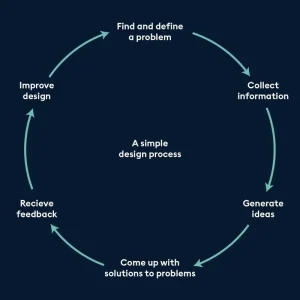
A number of different creativity models exist, each agrees on the basic process, variations exist mainly in the degree of categorisation. This model consists of a framework for deliberately finding and solving problems then implementing solutions. The circular nature of the model implies a continuous process as ones solution invariably leads to more problems and so on and so on. Each stage of the process contains many thinking tools to facilitate the problem solving process requiring two distinctly different types of thinking; divergent thinking that results in many ideas and convergent thinking resulting in one idea.
STAGE ONE – Understanding the Problem
Sometimes it is only a change in viewpoint that is needed to convert a seemingly tiresome duty into an interesting opportunity.
Albert FlandersDivergent thinking
Seeking opportunities for problem solving. Examining many details, looking at the mess from many viewpoints. Considering many possible problem statements.
Convergent thinking
Establishing a broad, general goal for problem solving. Determining important data to guide problem development. Constructing or selecting a specific problem statement.
1. Problem Finding
This deals with the question, what is the challenge, opportunity or concern? At this stage, the situation is broad, general and ill defined. The purpose of this stage is the identification and selection of a starting point. Successful completion of the mess finding stage requires visual mapping of general task area. This will establish the full range of possible opportunities by looking at the wider perspective of the task and clarify focus within the task establishing the direction to take. The use of mind maps is an invaluable tool to evaluate this situation.
2a. Fact Finding
Data finding requires seeking as much and as varied information as possible for examining and stating problems. By identifying factors and elements relating to the problem the context, people involved and desired outcomes can be closely examined, ensuring a complete understanding of the problem. Treffinger and Isaksen (1995) identified five different kinds of data that can be generated.
Information
Feelings
Observations
Impressions
Questions
Knowledge
Emotions
Notice
Intuitive guess
Inquiry
Facts
Sentiment
Perception
Hunch
Doubt
Intelligence
Awareness
Comment
Image
Difficulty
Memory
Desire
Watch
Expectation
Uncertainty
Recollection
Sensitivity
Regard
Sense
Curiosities
Facts and data will be, sorted and organised into levels of importance clarifying understanding of the situation. This can be arranged around important themes or issues relating to the problem. This often leads to further generation of data, general challenges or opportunities to be considered. The areas that data can be sorted will be; what we know, what we need to know and what we would like to know.
2b. Problem Definition
“A problem well stated is a problem half solved”.
John DeweyThis stage develops, stimulating and clearly defined problem statements in preparation for the idea generation stage. A problem is a specific gap between what you have and the opportunity to create something new. An effective problem statement will focus on the current understanding of gaps in present reality and a desired future state. The way a problem is stated has a powerful impact upon the ability to stimulate solutions. Avoid negative statements giving reasons not to react, for example; “We don’t have the support”, or “its never been done like that before”. Effective statements invite ideas, state the issue for which you really want ideas, are concise, locate ownership and are free from criteria.
An effective problem statement can be constructed by using the following criteria:
- Using and invitational stem for example. How might I…, in what ways might I…?
- Clearly identifying an owner. I, we, a persons name or group of people.
- Using a verb or action that identifies a specific performance.
- Identifying and object that is the focus of the problem solving activity to be conducted.
STAGE TWO – Generating Ideas
“The best way to have a good idea is to have lots of ideas”.
Linus PaulingDivergent
Producing many unusual and varied ideas
Convergent
Identifying promising possibilities, alternatives or options.
3a. Idea Finding
Four principal qualities exist when generating ideas, these are not mutually exclusive, as different problem solving situations will require different qualities. Some situations require a wide range of options, others novel ideas or a change of perspective. These qualities are
Fluency.
The ability to generate many options.
Flexibility.
The ability to generate many different categories of option.
Originality.
The ability to generate novel associations.
Elaboration.
The ability to add detail to options, make them richer, fuller, or interesting.
The principals of idea generation are primarily based upon divergent thinking, the process of generating many types of ideas. Effective idea generation requires certain attitudes without which quantity and originality will be limited.
Defer judgement. Idea generation relies upon suspending the analytical and judgemental brain, All ideas no matter how silly or impractical should be listed.
Quantity breeds quality This is dependent upon deferred judgement, more ideas can be generated when evaluation is suspended.
The wilder the idea the betterThe value of wild ideas lies in stimulating unique problem solutions which can be modified.
Combine and improve ideas Most ideas can be combined with one or more other ideas or improved upon by modifying one or more attributes.
Take a break from the problem Intense problem solving is tiring which may inhibit thinking restricting new perspectives and ideas,
Michalko (1998) states “What is important, is people should not memorise specific techniques: rather, they should try to remember the basic principals around which creativity is structured”. The basic principals are:
- Create multiple perspectives about the problem.
- Produce a quantity of ideas.
- Produce variation by introducing random, or unrelated factors provoking new thinking patterns by: making novel combinations, forcing relationships, thinking in opposites or using metaphor or analogy.
- Elaborate on these ideas.
- Evaluate the ideas.
3b. Evaluation and selection
Involves working on promising ideas to analyse, refine and improve them by applying criteria to the ideas examining and strengthening promising ideas. Care in avoiding jumping to conclusions based upon single criteria and hidden motives and improving flawed solutions is important.
“Few ideas are in themselves practical. It is for want of active imagination in their application rather than their means of acquisition that they fail of success”
John ArnoldThe quantity of options, quality of options, level of ownership and the demands of the task all influence how ideas can be turned into workable solutions. Failing to establish appropriate criteria through which ideas are evaluated will lead to good ideas being dismissed. Effective decisions require analysis and development using criteria which can be either in the form of implicit and internal or data, constraints or experience. Effective solution finding requires clear and explicit criteria.
The process of evaluation can be simplified by using a number of tools like evaluation matrixes, criteria headings or de Bono’s PMI (plus minus interesting). Whilst rational evaluation systems are necessary the use of intuition should not be overlooked.
STAGE THREE – Solution implementation
Divergent
Developing criteria for analysing, refining promising possibilities.
Considering sources of possible assistance/resistance and possible actions for implementation
Convergent
Developing criteria for analysing, refining promising possibilities.
Considering sources of possible assistance/resistance and possible actions for implementation
The final stages of the creative problem solving process require translating interesting and promising ideas into useful acceptable and implementable actions.
4. Action Planning
The end point is seen and the steps that are involved getting there are established in order to motivate people. By anticipating problems likely to arise establishing who will be negatively effected those standing to benefit and methods and timing for introducing the solution. As the old adage says “plan your work and work your plan.
5. Gaining Acceptance
The final stage of the problem solving process is to focus upon generating and identifying key sources of assistance or resistance in the chosen situation and developing action steps for implementing your solutions and overcoming individual and organisational barriers. This will form the basis for any action plans and insure that the solution will be acceptable to you and others, and that you have a careful, thoughtful and practical plan containing specific steps to be taken. Isaksten, Treffinger (1985)
The first phase should be to identify the people, places, objects, times, reasons and actions that might help or hinder implementation. The selling of ideas requires interpersonal skills in order to win support and approval. Implementing solutions without considering important concerns, preparing to overcome them may result having to solve future problems or the possibility of the plan failing.
6. Taking Action
Communicating new ideas so they are accepted by others is known as “diffusion of innovation” This is described by Rogers (1983) as an information exchange occurring as a convergence process involving interpersonal networks. He identified specific attributes of innovations describing the characteristics as: relative advantage, compatibility, complexity, trialability, and observability. Asking questions that are based upon these precepts will assist in examining the effectiveness of the action plan.
-
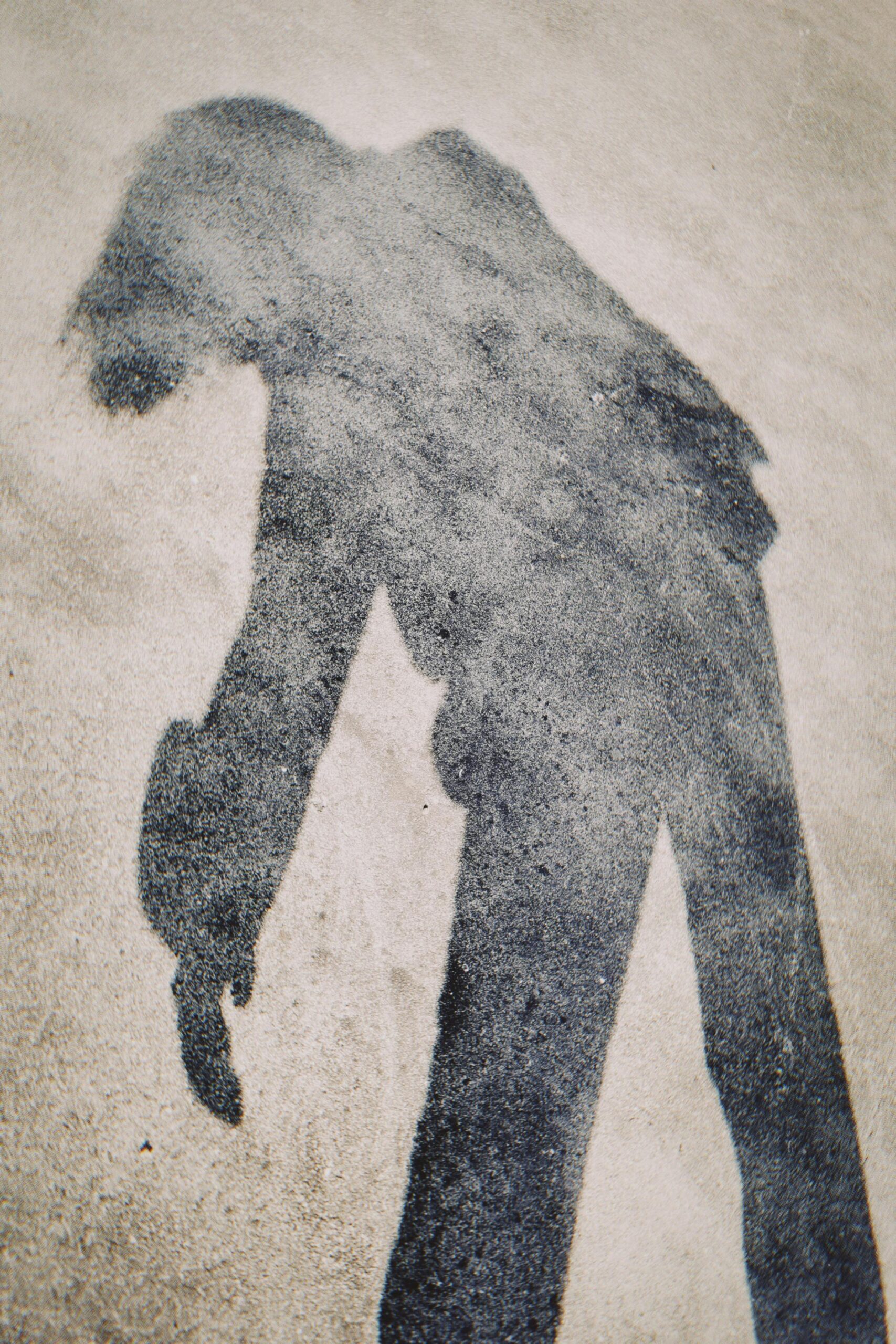
The Creative Person
Is a person involved in the arts or design different from other professions? Physically no but creative people certainly have personality, learning styles and character traits that are different to that of an accountant or engineer. The process of design uses thinking styles from all parts of the brain from the intuitive to analytical. Designers also display distinctive personality traits and a particular view on life in order to access their creativity.
Carl Jung developed a framework to help people become more effective. He identified two types of attitude; extrovert and introvert and four mental functions for taking in and processing information;.
Sensation
Uses the body and senses to know
Intuition
Knowing without knowing how you know.
Thinking
Conclusions formed through logic and objective reasoning.
Feeling
Decisions based upon subjective, personal, cultural and organizational values.
These two attitudes and four functions form a framework now referred to as the Myers-Briggs Type Indicator (MBTI). This indicates preferences for using the talents in a certain order and the interactions between talents influencing perspectives, assumptions anmd approaches to creative solutions and the results produced. Myers and McCaulley, state that “preferences are like handedness; one uses both hands, but reaches first with the preferred hand which is probably more adept”. The MBTI indicates distinct cognitive preferences for people in design related industries. The most frequently found personality types in the arts are;
1. INFP
Introversion
Intuition
Feeling
Perception
2. INFJ
Introversion
Intuition
Feeling
Judging
3. ENFP
Extroversion
Intuition
Feeling
Perception
4. ENFJ
Extroversion
Intuition
Feeling
Judging
These results indicate designers overwhelmingly preferring intuition as a way of perceiving their world. McKinnon (1978). states “A preference for the perceptive attitude results in a life that is more open to experience both from within and from without, and is characterised by flexibility and spontaneity”. Intuition measured in this test places 100% of architects as being intuitive in contrast to 25% of the general population.
Designers display above average ability in certain facets of Gardner’s theory of ‘multiple intelligence’. Gardner (1983) identifies seven different forms of intelligence: Linguistic, musical, logical, mathematical, spatial, bodily kinesthetic, intrapersonal and interpersonal. Recent developments include the addition of naturalist, spiritual and psychic intelligence. Designers display greater ability in spatial intelligence, the capacity to perceive the world accurately and recreate the visual experience. Spatial intelligence is not tied to the visual sense it is the ability to discern differences across a wide range of domains including abstract and analytical abilities.
The education system places very little value upon the unquantifiable traits a designer uses as the principal source of their inspiration. As creative individuals we have managed to escape an education system that has deprived us access to many qualities of the right brain. Education systems are designed to cultivate the verbal, rational, time based left hemisphere, resulting in half of the brain of every student being ignored. A US study found only 1.7% of the total academic curriculum to be involved with divergent skills. Edwards (1987).
Right brain characteristics (the characteristics required for much spatial intelligence) are undesirable in a structured curriculum. The right hemisphere does not control logical propositions or sequencing, starting wherever it wants, working holistically, with poor time sense and naming skills. It is unlikely that imagination, visualisation, perception, spatial skills, creativity, intuitiveness and inventiveness will be emphasised in mainstream education, resulting in loosing access to the qualities of the right brain. Fortunately, for some these skills are developed, but our culture is so strongly weighted towards rewarding left-brain skills that we loose a large proportion of our potential abilities. The creative designer needs to relearn how to use their right brain skills in order to approach design with the necessary logical left brain and intuitive right brain processing that creativity requires.
The wide range of thinking languages that are available also need to be practiced in order to aid the means by which information and operations represent themselves in the conscious. Verbal and written language is the most common (left brain), other languages include non-verbal languages like mathematical, musical, sensory, emotive and visual. Education systems and the individual who develops these sensory skills will have several advantages over those who only use single thinking languages;
- Sensory and imaginative abilities can be vitalised rather than atrophy.
- Vehicles are provided that is more appropriate to the thinkers needs than language.
- Education in sensory thinking encourages flexibility in thinking levels
- Thinking by sensory imagery encourages the thinker to utilise operations that are not within the realms of language. McKim (1980)
Thinkers who know when to stop thinking consciously, relax and let the subconscious take over demonstrate flexibility. Productive thinkers are also alert to recognise ideas that emerge from the unconscious.
McKim (1986) proposes three conditions that will foster thinking that is productive and creative:
- Challenge. This requires a situation in which change is desired
- Information. This must be correct, adequate and accessible for processing to be productive
- Flexibility. This can be achieved in three ways. Firstly, access to the conscious as well as subconscious levels of thinking. Secondly, proficiency in a verity of mental operations and the ability to move freely from one to the other. Finally, utilisation of several vehicles of thought and be able to transfer between them.
Good conceptualisation and creative actions of all kinds are enhanced considerably by fantasy; reflection and mental playfulness, Roger van Oech (1997) asked his clients, “During what kind of activities and situations do you get your ideas?” the replies fell into two categories. The smaller group represented replies such as: “When faced with a problem, when things break of need fixing, when the deadline is near”. The larger group represented replies such as: “When I am playing around, when I am doing something, and after my second beer”. He draws the conclusion that if necessity is that mother of invention then play is certainly the father. When defenses are down, mental blocks are loose, concern with the rules is minimal and the mind is allowed to move freely towards creative ideas. Creative people move between their childlike and mature character traits. The qualities of the child’s lack of concern with rules are desirable for stimulating creative action. If we are daydreaming or playing, the assumption is, we are being unproductive, the opposite is often the case.
Individuals must believe they are creative. Shell Oil in Rotterdam, Holland, employed a team of psychologists to establish the qualities that made some people creative and others uncreative. Their conclusion was that the creative people thought they were creative and the uncreative believed they were uncreative. The words of thought and resultant action overlap, what you think has a way of becoming true a theory practiced by exponents of Neuro linguistic programming and other methods of personal development. The self-belief that ideas are worthy and worth building on, more than one answer will be sought; ideas in other fields explored, ambiguity tolerated and a more playful attitude to ideas adopted. Using creative affirmations like “My creativity is unlimited” is one way to foster a belief in personal creative potential.
People who display creative ability display some of the following characteristics. The principals being the belief you are creative and have the motivation to grow and the energy to commit to creative development. Creativity is a state of being, the reward of which is to make day to day experiences more vivid, enjoyable and rewarding. Which traits can you foster to develop your creative potential?
The following simple activities will increase creativity when incorporated into a busy daily life.
Use thinking tools
Actively use tools associated with all the stages of the creative process; problem identification, idea generation and implementation. Practice broad and rigorous questioning, mind mapping, challenging assumptions, multiple perspectives, making novel connections, random input, analogy, and metaphor, visual, perceptual and sensory languages.
Build a brain trust
Surround yourself with inspiring people and artefacts from diverse fields, Read very broadly, visit shows, exhibitions, go on trips, try new hobbies, Exercise your brain by reading with diversity, disagreeing with smart people, playing puzzles and intelligent activities.
Capture daydreams
Meditation, relaxation provides access to the subconscious a vast source of insight; daydreams appear as metaphor how can these be interpreted to show a fresh perspective. Keep a daily journal for self reflection and exploring blocks, always carry a small notebook and record your ideas. An idea not recorded is an idea missed.
Play with passion
Have fun, a sense of humour, recapture childhood joys and bring this into your work, do the things you enjoy, a fulfilled person is a creative person. Slow down and see the world through a child’s eyes.
Make sure you exercise.
Exercise = glucose = increased brain activity. Exercise increases oxygen, releases endorphins, increases nerve connections, and helps spatial awareness. Go for a walk or play a game. A change of environment and exercise is good for you.
Eat brain foods
Fish, Omega 3, Ginkgo Biloba, Vitamin B strengthen neural connections, increase speed of thought and blood flow to the brain. Eat fresh, natural, diverse foods. Drink lots of water. Don’t do drugs. People on drugs think they are being creative to everyone else they seem like people on drugs.
Listen to music
Slow, 60 BPM and high frequency music stimulates neural connections, theta waves and biological rhythms connected with thinking. The fast and simple rhythms typical of rap and rock are great for dancing but to be avoided when thinking.
Use Aromatherapy oils
Smell stimulates the brain, particular odors are suited for particular activities, relaxation or stimulation, Basil is the best all round odor for creative thinking, in addition you need a stimulating smell like Geranium and a relaxing smell like frankincense.
-
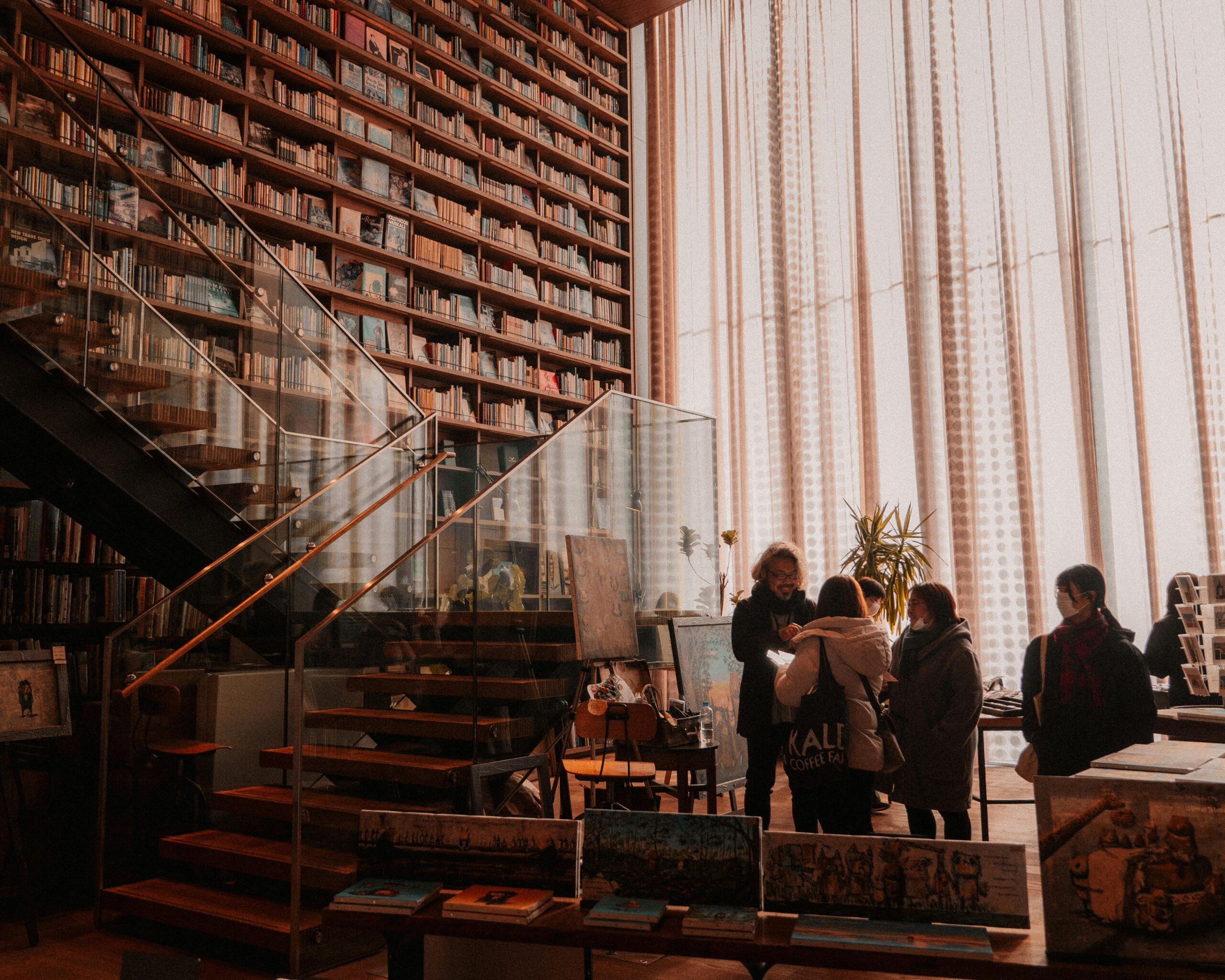
The Creative Space
Can physical space increase creativity? The answer is an ambiguous yes and no. There are many examples of physical environments completely lacking inspiration yet the organisational culture allows creative action to take place. The ‘skunkworks’ concept in which a team of brilliant engineers and scientists create revolutionary aircraft in a dingy back room. In these instances the right balance of motivation, ability and domain knowledge drive creativity. Equally environments are designed with all the right elements of light, colour and stimulating visual objects and images yet as creative as a straight jacket.
Some of histories great thinkers have created environments and conditions to stimulate their thinking. Proust worked in a cork-lined room. Mahler wrote his music in a tiny cottage in the middle of a meadow. During the Roaring twenties many noted writers and artists believed that Paris to be the only city worth living in. Dickens turned his bed and writing desk to face north, believing himself to be enabled by the magnetic forces. Schiller favoured the scent of fermenting apples.
Stanford University professor Robert McKim built the ‘Imaginarium’, a geodesic dome where design students lie about on floor cushions. They are treated to a controlled sensory experience that consists of pictures and colours, which flash on the wall, sound effects, frequencies and music. Vibrations and rhythm are felt through the floor, and odours are piped in through the ventilation system. This stimulates mental imagery, freeing the imagination to let it roam and experience what it may. A multi-sensory environment, using natural or full spectrum light, colour, smell, sound, visually stimulating images, objects and associations will stimulate creative thinking.
The cultural space
A creative space will not solve the problem of uncreative thinking but it will help to focus attention and stimulate the mind. In order to really stimulate creativity the most important factor is that the organisation must value creativity. Once the value of creativity is acknowledged by the leaders and passed throughout the organisation then a creative culture will be established. The ideal culture will stimulate to both intrinsic motivation, from inside the person and extrinsic motivation, derived from the external environment. These types of motivation are achieved through a flexible culture that is seen as belonging to and supports the needs of users. This is combined with an attractive and stimulating space, rewards and recognition.
Adams 1987 identifies a number of environmental blocks to organisational creativity. The majority require management strategies to implement. An autocratic leader, who only values their ideas or does not support initiatives to bring ideas into action then fails to or uses inappropriate rewards and is overly bureaucratic. A focus on building an appropriate organisational culture encourages creativity. Responsibility for creating a positive culture lies throughout an organisation through actions like overcoming a lack of trust, respect and co-operation between colleges, avoiding distractions, critical evaluation of others. The final element creating a stimulating physical space should be easy for all designers apart from minimalist style fascists responsible for the mind-numbing monotony in many “clean and simple” white box interiors currently fashionable, such spaces are the death knell for stimulating creativity.
Creating a positive creative environment requires thought being given to simple management strategies like; Choosing stimulating people who want to share ideas, the freedom to take the initiative, providing the challenge and motivation to achieve personal growth, good project management and inclusive communication using a range of methods, sufficient resources, encouragement and recognition from colleagues and bosses, a collaborative atmosphere where egomaniacs are locked in sealed rooms and individual strengths and weaknesses are recognised. A creative culture will tolerate mistakes and use them as a means of reflection and learning.
This is not to say that we should accept the laws of the politically correct thought police as conflict and healthy debates backed up by the willingness to take risks will tease a truly creative solution into reality. This process requires trust and openness so you feel safe in sharing your ideas. An organisation that enjoys playfulness and a sense of humour will create a relaxed atmosphere in which ideas are much more likely to flow. Alternatively the installation of a games room containing a diversity of activities for mental and physical stimulation will be a safe environment to look for and chase ideas. Recognition that idea time which may involve activities that on the surface appear to be unproductive like staring into space or going for a walk must become necessary. Creativity takes time and needs to be regarded as a long term journey and investment in yourself and your organisation.. Once ideas are being discussed idea support needs to be provided. Ideas should not be dictated by research because great ideas usually come from inspiration. Even the best ideas are doomed if time and money are not available for effective development”
The physical space
Once organisational culture has been established the elements of a creative space can be implemented. The primary consideration for the designer is to appeal to all the senses and provide an environment that appeals both directly and also subconsciously. Allow flexibility so individuals each with different learning and personality styles can adapt the space to suit individual idiosyncrasies.
A creative space will support creative collaboration to the degree that it attracts teamwork. Open spatial layouts facilitate open communication and integrate disciplines which make collaboration and cross pollination much easier. Spaces should be inclusive and non hierarchical. Areas that enable group social interaction to take place and have a variety of colour, atmospheres and sense of fun. Research by Steelcase found that 80% of creative ideas happened in informal areas and assign 70% of their corporate headquarters to informal space. Promoting creativity in the workplace usually involves tearing down walls be they mental, physical, operational or political.
Furnishings need to be flexible with the possibility for reconfiguration to change with projects and staff. Provide lots of work surfaces and seating that encourages postural variation like reclining, lying, squatting and sprawling. Get out and about, sitting behind a desk behind a pile of paper and computer screen is possibly the worst place for creativity the size of their ideas being directly in proportion to their cubicle. Furnishings can be used to create a feeling of being comfortably disoriented by challenging expectations, they need to wake up the brain not send it to sleep and shout out collaboration.
Lighting, should be plentiful and preferably natural or at least full spectrum. Full spectrum lighting has been shown in studies to help calm the brain, and nervous system, reduce fatigue and eyestrain.
Temperature should be set at between 18 and 21 degrees C preferably slightly on the cool side with lots of fresh air, this will help retain mental and physical alertness during the day. The addition of an Ioniser will eliminate positive ions which are attributed to many airbourne diseases and poor performance.
Colour choice needs to be undertaken with care as the effects upon the human psyche can be powerful, generally, warm colours will excite and cool colours will relax and calm. Colour therapy claims colours affect the mind and body in different ways.
Red
Symbol of life, strength and vitality, powerful, energising and stimulating.
Orange
Symbol of feminine energy, joy and happiness.
Yellow
Symbol of the mind and intellect, inspiring and stimulating.
Green
Colour of balance, harmony and sympathy.
Blue
Symbolises inspiration, peace and tranquillity, creates space and expansion.
Indigo
Helps broaden the mind, free of fears and inhibitions.
Violet
Relates to spirituality, self respect, insight and inspiration. Many great musicians, poets and painters write that their greatest inspiration comes from predominantly violet environments.
Magenta
Enables us to let go of ideas and thought patterns
In terms of stimulating the brain both alert and relaxed states are necessary for different parts of the creative process therefore some colour variation is necessary. Walls should contain stimulation ideally a constantly changing range of images, pictures and quotations.
The effects of music have recently been shown to have a significant effect upon the brain. The so called Mozart effect (Cambel (1997) finds music containing a specific beat and frequency increases performance in visual and spatial tests. We all know that different music will excite us make is romantic, sad or sleepy. With this awareness different types of music can effectively accompany different parts of the creative process. Use lively, fun music to energise during the initial warm up and slow high frequency music like Mozart violin concertos during idea generating and thinking sessions. The book “tune your brain by Elizabeth Miles provides extensive discographies for selecting music appropriate to mood and task.
Providing a space for employees with lots of puzzles especially of the three dimensional kind like Rubik’s cube and their many variation, games and fun objects creates an environment where fun and humour is encouraged as well as much needed visual stimulation. When puzzles and games are interspaced with creative thinking they provide the opportunity to turn off the mind and allow the subconscious to take over the problem solving process, make work seem much more fun and utilise the kinaesthetic senses.
-
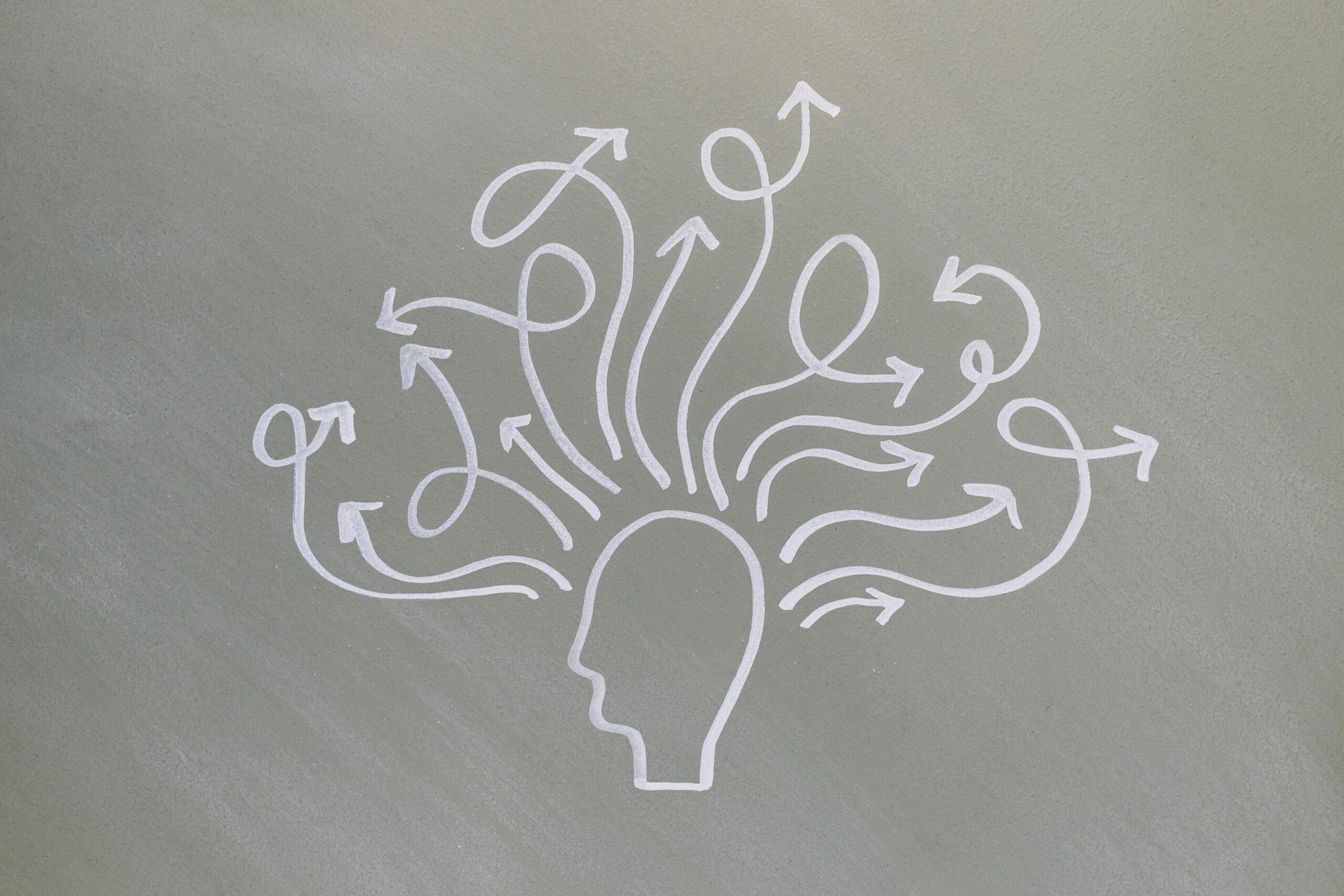
The Creative Subconscious
“It is with the heart that one sees rightly; what is essential is invisible to the eye.” Antoine de Saint-Exupery. The Little Prince
Only within the last two decades has it become acceptable to acknowledge the important role the subconscious plays in everyday life without too much ridicule. The Quantum nature of the universe has demonstrated we live in a multi dimensional universe, unlimited by space or time with the inner world directly linked to that of the universe. As research into creativity has developed, the importance of the subconscious in creativity has become very apparent. So what can we do to increase our intuitive and subconscious faculties? The answer is a lot, although many of these tools require a long term focus with limited short term results, practice being the key to success. The benefits from becoming intuitively in tune are immense in terms of increased creativity.
Human beings have the ability to symbolise experiences in our minds, our thinking is not limited to the real or present. Intuition delivers information through flashes of insight or hunches and gut feeling attaining knowledge unfiltered by rational thought. This capability empowers our thinking by enabling us to simulate possibilities, anticipate and plan the future. By using visualisation and imagination we can generate ideas that have no correlation to the world of experience.
Evolutionary biologists claim that intuitions main purpose is physical growth and adaptation to insure the perpetuation of our species. Adequate information is required to protect against threats to our life and provide the opportunity to achieve our full potential. Ferguson (1999) describes Intuition is as sensory process in human beings triggered by particular kinds of interactions both inside and outside our bodies that influence our stability and optimal performance. It affects our behavior, feelings and thoughts so that we either move involuntarily or receive factual information that provides direction for our decisions about what moves to make”.
The sub-conscious plays an important role in problem solving. Szilard (1990) commenting on scientific discoveries states. “Insights that have lead to a breakthrough were not logically derived from pre-existing knowledge: the creative process on which science is based operates at the level of the subconscious”. The ability to think hard about a problem, stop and do something else frequently leads to new ideas and answers at a later date. The barrier to developing intuition is stress; the inability to relax prevents the inner and outer senses from working together keeping the mind on guard against non-serious activities This results in difficulties using thinking skills that are necessary for fluent and flexible thought.
RELAXATION AND VISUALISATION
Developing intuition involves relaxation and attention. By releasing irrelevant tension, the individual provides full energy and attention to the task at hand. Relaxation is important to thinking generally, because humans think holistically with our body as well as our brain. Overly tight muscles divert attention, restrict the flow of blood, waste energy and stress the nervous system, leading to an uptight body and thoughts. Physiologists have shown that some muscular tension is required to generate and attend to mental processes, some but not too much: relaxed attention. (McKim 1980)
The importance of relaxed attention to creative thinking is well known. Typically after a period of intense focus, letting the problem incubate whilst taking a shower, a walk or sleeping may let the subconscious form a solution. The sudden flash of insight requires relaxation to let thoughts flow and attention to be aware of it before it is lost. A survey by Thompson (1992) found the toilet, in the shower, commuting, driving, dozing in meetings; night time, sermons or exercising and manual labor the best places to get an idea using relaxed attention. More importantly no one claimed to get good ideas in the office and every setting involved fun and pleasure.
Physical relaxation techniques provide an excellent way to break cycles of fear, worry and tension. Through relaxing physical tensions, the ability to maintain a negative psychological state decreases and the ability to think creatively is enhanced. There are two ways to achieve a relaxed state, passive and dynamic. Dynamic, involves activity; passive, involves lying down and going limp.
Guided by reality and illusion the power of imagination can be used creatively or destructively depending on our choice. Mental visualisation uses the power of the mind in activities as diverse as professional sport, a businessmen visualising a top performance to a yogi surviving being buried alive. Creative visualisation and directed fantasy strengthens the ability to control the imagination.
Mills (1994) identifies three types of visualisation. Receptive visualisation, involves conscious immersion in the problem, closing the eyes and relaxing or doing something different, then letting the subconscious take over. Programmed visualisation involves communicating with the subconscious. Guided visualisation involves painting a mental image but leaving out detail which the subconscious completes.
Clarity of mental images ranges from detailed to blurred impressions. Vivid and clear imagery is frequently not desired in visual thinking, these impressions are informed through multi-sensory input. Mental operations that involve abstraction, flexible manipulation and creative synthesis are obstructed by detail. Visual memory on the other hand is generally facilitated by clear imagery, as is the visualisation of concrete ideas.
DREAMING
A primary source of visual imagery is autonomous imagery. This is imagery that is not susceptible to conscious control like dream imagery. Autonomous imagery includes hypno-gogic and hypno-pompic imagery, (imagery experienced just before falling asleep or in the drowsy state before waking) daydreams and hallucination. Many well known creative people including: Richard Wagner, Edgar Allan Poe and Thomas Edison report using hypno-gogic imagery as source material. This imagery can be cultivated using the following the steps.
- Before falling asleep consciously relax your body into a state of deep muscle relaxation
- Concurrently, stop inner speech by silencing verbal thinking.
- Relax the eyes. Conscious focusing and scanning will cause hypno-gogic imagery to recede.
- To avoid falling asleep with the minimum of effort hold an arm in a vertical balanced position, muscle tonus suddenly decreases and when the arm falls you suddenly awake
- .Record experiences as soon as possible before they fade.
Even without dreaming the productive thinker controls his inner imagery, manipulates it, transforms it and moves it along towards a desired goal. Imagination games will direct the imagination opening the possibilities inherent in fantasy developing their imaginative capacity. Self directed games must make sure that rules are broken as often as kept. Icebergs are hot, spiders bark, Trees sing. Defying normality clarifies the distinction between reality and fantasy strengthening control of the imagination.
The power of dreams is familiar with many well-known thinkers. Blake, Voltaire, Tolstoy, Mozart, Descartes, Bohr, Telsa and Kekule all describe dreams in their problem solving process. Dreams are a potent force in many non-western countries and acknowledged in the west through the work of Jung (1962) as having a particular force. He states …There are these particular faculties of the psyche that show it isn’t confined to space or time. You can have dreams or visions of the future, you can see round corners and such things. Only ignorant’s deny these facts. It is quite evident that they do exist and have existed always”
Price & Haynes (1997) argue that dreams serve a certain function. Firstly, as a means of exploring personal growth. Secondly, as a way to reflect and learn from past events and finally and most importantly point to solutions to life’s future problems. McKim (1980) states. “In the west the thinking we do while asleep usually remains on a muddled, childish, or psychotic level because we do not consider dreams as socially important and include dreaming in the education process. This social neglect of one side of man’s reflective thinking, when the creative process is most free, seems poor education”.
The natural resource of the human is barely tapped and when placed within the infinity of the universe to say we only use 10% of our potential is wildly optimistic. Practising visualisation, becoming sensitive to the sense of intuition, refusing to believe our negative mental energies and believing in ourselves can lead us to exciting creative opportunities.
INTUITION
It is probably only the intuitive leap that will let us solve problems in this complex world. This is the major advantage of man over computer.
Tom Peters and Robert Waterman.Intuitive decision-making based on research by Dean and Mihalsky (1974) found executives of the companies that more than doubled profits had a far higher intuitive ability based on predictive testing. They also found dynamic people who got more done in a day also had a far higher intuitive score.
“Intuition is the function that explores the unknown, senses possibilities and implications which may not be readily apparent”
Carl JungWe can avoid a lot of unhappiness if we know how to respond to a given situation. Relying upon our memories is a poor strategy for the simple reason that memory manipulates our memories. What we need to do is to be far more attentive to our emotions as soon as they happen before they are distorted by judgments, ideas and memories this is a process that involves being in the moment. Being in the moment means we need to listen to our intuition.
Intuition from the latin intueri meaning looking or knowing from within.
Intuition comes from within you. It begins with self-awareness and then interfaces with awareness of the surrounding environment combining to make sense of a situation. A combination of intuition with reason and logic provides fertile new ground for perception and thinking.
How not to be intuitive
Before you start to develop your intuition you must remember that you will not awaken your intuition if lost in a tense noisy world, if you are in emotional or mental turmoil or when you are stressed. You will not respond to signals if you are reliant upon words as intuitions language is emotional and sensory. Intuition is impaired by; wishful thinking, acting out of fear, when you are too embedded in a sense of ownership or when you project personal needs onto someone or something. Don’t expect intuitive insights to come to you with flashing lights and a booming voice, the messages are often very subtle and easily missed if you are not aware.
The only really valuable thing is intuition.
Albert EinsteinBEING INTUITIVE
You will awaken your intuitive abilities when you are STILL, CENTERED and RECEPTIVE. To use intuition effectively, simply believe it works and you can receive guidance from your higher self. The more it is used the more available, quicker and powerful it becomes.
Intuition is non-rational, non-linear, insightful, non-data based, and read in the body as an extension of the five senses. There is always a preferred sense for example listeners may tilt their heads to one side until they hear the answer. Visual people may squint then focus when they see the answer. Touch people may rub their thumb and forefingers together until they feel the answers. In all cases intuition includes a heightened sense of awareness through the senses. Therefore in order to develop heightened intuition learn to intuit though your preferred natural sense.
Intuitive signals are received through the senses in five main ways
Physical
(body)
Gut feelings, stomach ache, tension headache, adopting another’s pain.
Mental
(mind)
Eureka or aha effect, pieces of a problem, come together forming a new theories.
Emotional
(heart)
Immediate like or dislike, sudden change of mood, without logical provocation.
Spiritual
(soul)
Awareness of a connection beyond the physical world.
Environment
(place)
Cues from the environment sending messages, flat tire telling you to miss a meeting.
Intuitive problem solving follows the following process.
How to develop your intuition.
1. Honour
Respect flashes don’t label any as silly or coincidental.
2. Brevity / Simplicity
Express flashes in a brief word, talking is for the logical brain.
3. Symbol/Picture/Imagery
Intuition turns on pictures for you to receive.
4. Suspend assumptions
Use intuitive input as naively as possible avoid preconceived ideas.
5. First impressions
Initial ideas are usually correct.
6. Faint Stirrings
Respect weak impressions as strongly as the blinding flashes.
7. Active / Passive
Intuitions can come unexpectedly or when consciously sought.
8. Relax
Letting go of tension helps with receiving impressions.
9. Associate
Freely associate to the imagery will help unravel symbols.
10. Playful moments
Enjoy the process, fun weakens analysis and strengthens the flow.
Intuition can extend your awareness to an unlimited extent. With intuition you can project your awareness to any time and place. The goal of applying intuition is to direct awareness to gain useful information. We choose what we encounter and make decisions about what we notice. Some notice beauty other grime. Where we can really use the conscious mind is in noticing the choices we make. If we find ourselves only seeing the negative we can notice that preoccupation and look for the good.
Intuition will tell the thinking mind where to look next.
Jonas SalkASKING INTUITIVE QUESTIONS
Be careful what you ask for you may get it. You must be careful with the questions you ask of your intuition because you will surely answer them. An ancient example of an ambiguous question put to an intuitive occurred in ancient Greece. A powerful ruler about to invade the lands of an enemy kingdom asked the Oracle at Delphi whether a great battle would be won. The oracle responded in the affirmative. The oracle was correct; the battle was won. Unfortunately for the king, it was by his rival. Had he known as much as you now know about questions he would have asked a question along the lines of “will I successfully invade my rivals kingdom tomorrow” or better still “will I successfully invade my rivals kingdom tomorrow at an acceptable cost?”
Its easy asking questions we don’t intend to ask for example suppose you ask “will it rain tomorrow” the answer has to be “yes” because somewhere in the world it will rain. A question properly phrased is half answered. Understanding what you are asking often reveals much of the answer. Poorly phrased questions are ambiguous and can be interpreted in more than one way.
The requirements of a good question
- The question must be specific and unambiguous so a precise answer is possible “will it rain tomorrow in Auckland city centre”.
- Each question must be simple rather than compounding “Will I get the Jones contract and be promoted” (your intuition will address the first half only)
- The question must be directly relevant to the issue you want to know about. Know what you are asking. don’t ask “is Twiddletech a good company” when what you want to know is whether Twiddletech are financially secure and represent a good investment.
Once you have relaxed and received an image through your senses you will need to figure out what this means, as these messages are rarely literal. For example your problem is should I accept a contract offer. a Kauri tree may indicate that your answer is strong, rare, growing, green or expansive you then need to decide out which one is relevant to your situation and how it resonates with you.
Ways to develop your intuition
Spontaneity There is only one moment in life and that is NOW! Being spontaneous is being free from the past and not worrying about the future. Be present and you will be amazed at what creative forces come to you.
Paying Attention / Observant Creativity requires an attentive state. If you pay attention and observe then you can discover ideas rather than being in your head shut off to everything around you and trying to invent good ideas.
Being Open you need to have an openness both mentally physically to go wherever the creative journey may take you. Your mind and body are two parts of one system and you cannot change one without having an effect on the other, therefore both must be open. Open yourself up to new experiences, be open to what people are and aren’t saying to you, look for what is new, what you could learn, what you could attempt.
Relaxed Alertness Like a top performance athlete, you need to be relaxed and alert. That way you’re not in your head trying hard to have a good idea and instead are alert to discover everything around you. Relaxed alertness allows you to be present whereas a stressful state has a narrowing impact on the mind and body.
USING THE INTUITIVE PROCESS
- Relax,
- Think of a problem that you would like to find an answer to
- Resolve a personal issue
- Important decision at work
- Understand unpredictable personality
- New perspective for positive action
- Discover a creative or innovative approach
- Frame the problem correctly based upon questioning structure and write it down.
- Elicit an image. Which of your senses were engaged during the process?
- Draw a mind map using words you associate with the image you received. Do any of the words link, can you see a pattern?
- If you have time, forget the answer and allow your subconscious to process the ideas generated.
- Decide upon a course of action.
Provoking insight
Some suggestions for enhancing skills that will provoke insight:
- Immerse yourself in others projects and be yourself.
- Ask questions that clarify hidden aspects of issues in different ways.
- Identify hidden assumptions and help them by posing ambiguities.
- Make provocative statements that lead to additional insights.
- Help people to search for solutions not just one answer.
- Help others to balance their feelings and thoughts in order to balance intuition and analysis.
- Help people to shift their way of doing things so they develop new habits.
- Help others to discover flaws in their thinking.
-
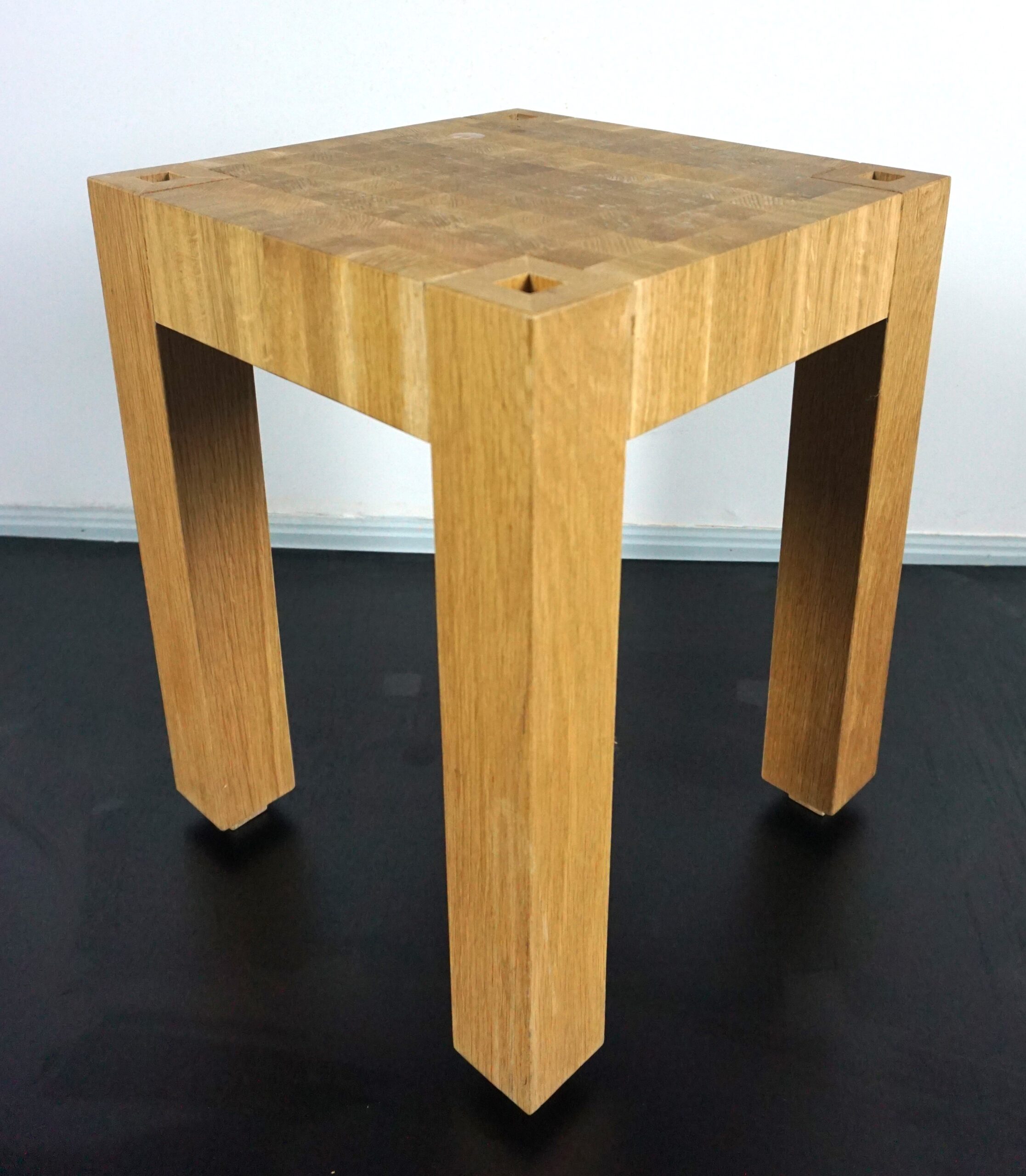
Butchers Block. Side table
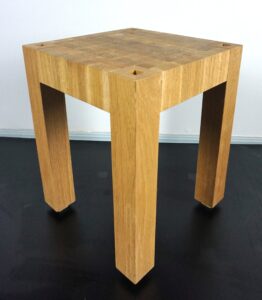
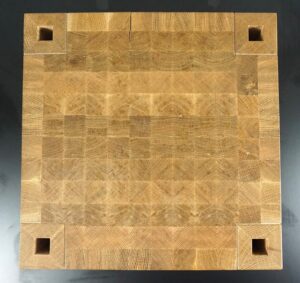
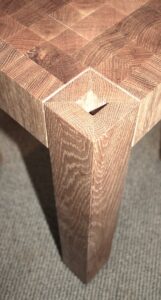

A solid eye catching side table, featuring a butchers block end-grain style construction top. The top is made from laminated blocks of 30 x 30 x 70mm laminated blocks of end grain. The legs are made from mitered strips of Oak which form a square with a central hollow. The table is finished with 3 coats of water-based lacquer and then wax polished. Size 360 x 360 x 470. Also available in different sizes on request. The table must be kept out of direct sunlight and temperature and moisture variations to stop the top expanding and contracting.
From $900
-
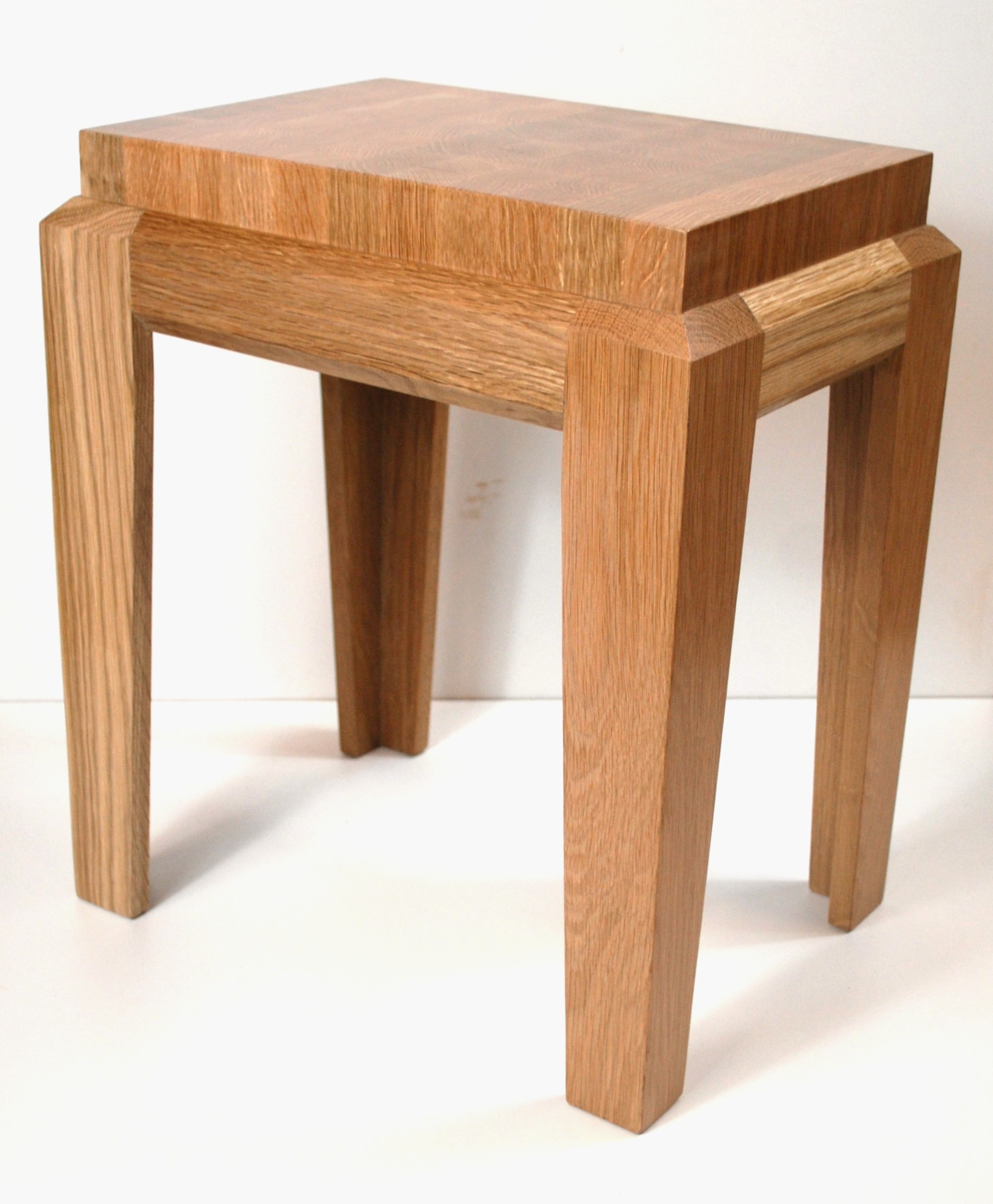
Framed Block. Side Table



A solid eye catching side table, featuring a butchers block end-grain style construction top. The top is made from laminated blocks of 30 x 30 x 70mm laminated blocks of end grain. The leg frames are made from Oak featuring a champhered edge connected to tapered legs. The table is finished with 3 coats of water-based lacquer and then wax polished. Size 360 x 360 x 470. Also available in different sizes on request. The table must be kept out of direct sunlight and temperature and moisture variations to stop the top expanding and contracting. L 300 x W 300 x H 420.
From $800
-

End Grain Oak. Occasional table
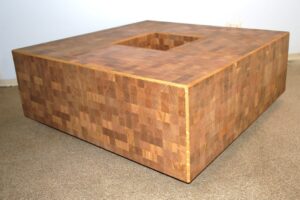
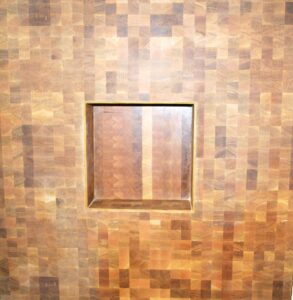
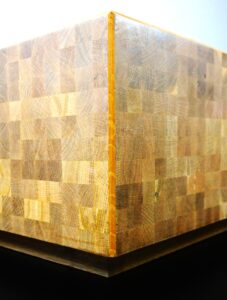

Designed to exploit the beauty of end grain Oak and to act as a centrepiece in a room. The top features a central recess that can be used for storage or display. The form is accentuated with a solid oak line around the edges and raised of the ground by an inset black plinth so it appears to float. The table is finished with a low sheen lacquer. The table is made from 50mm thick panels and is consequently very heavy. The table must be kept away of strong sunlight, temperature and moisture variations.
Size L 900 x W 900 x H 350.From $8000
-
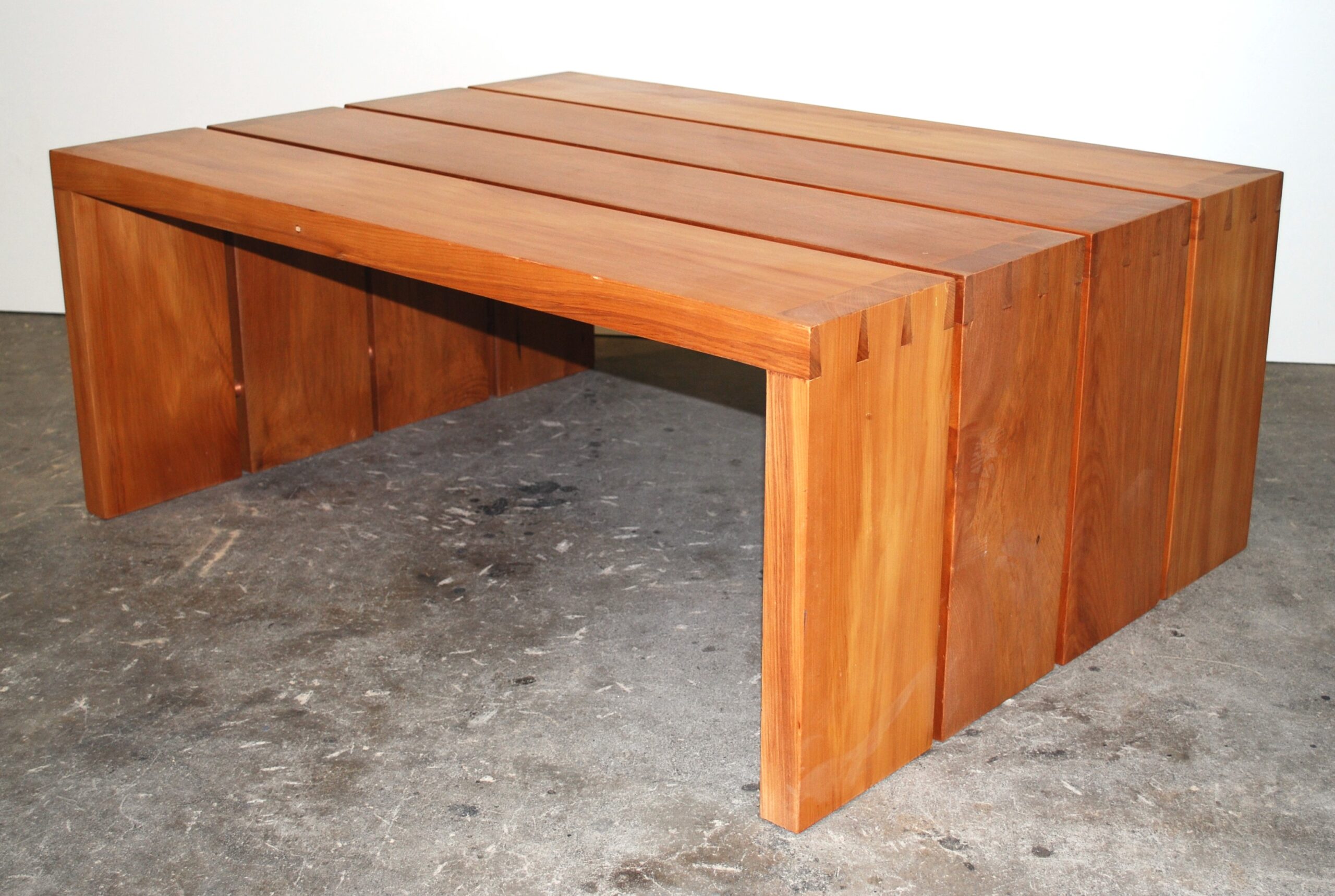
Hobsons Joists. Occasional table
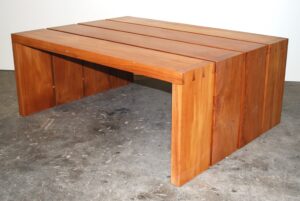
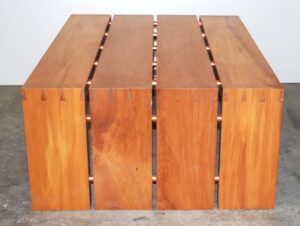
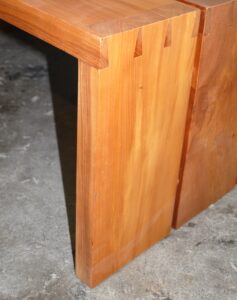
The original source for the “Dovetables” range. A series of n sections that are joined at the corners with hand cut dovetails. Each section is linked with polished copper tubes. The original design is made from Heart Rimu and Matai which was rescued from a warehouse on Auckland’s Hobsons wharf before the property development took place building the 1994 Americas cup village. L 1000 x W 800 x H 420.
-

Stevens. Chest of drawers
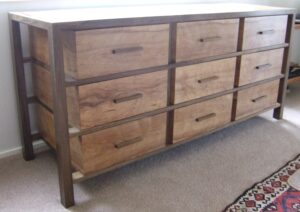

The chest of drawers was designed to hold a large collection of CD’s in the home of a collector of fine furniture. The intention of the design was to reduce a standard cabinet carcass to the bare minimum and also accentuate the decorative potential of the drawer boxes. The frame construction was inspired by using Japanese joinery techniques for the three way mitered corners ‘Kane Tsugi’. The cabinet is made in Puriri for the frame, Black Mairi and Yellow Cedar. L 1600 x W 500 x H 800.
-
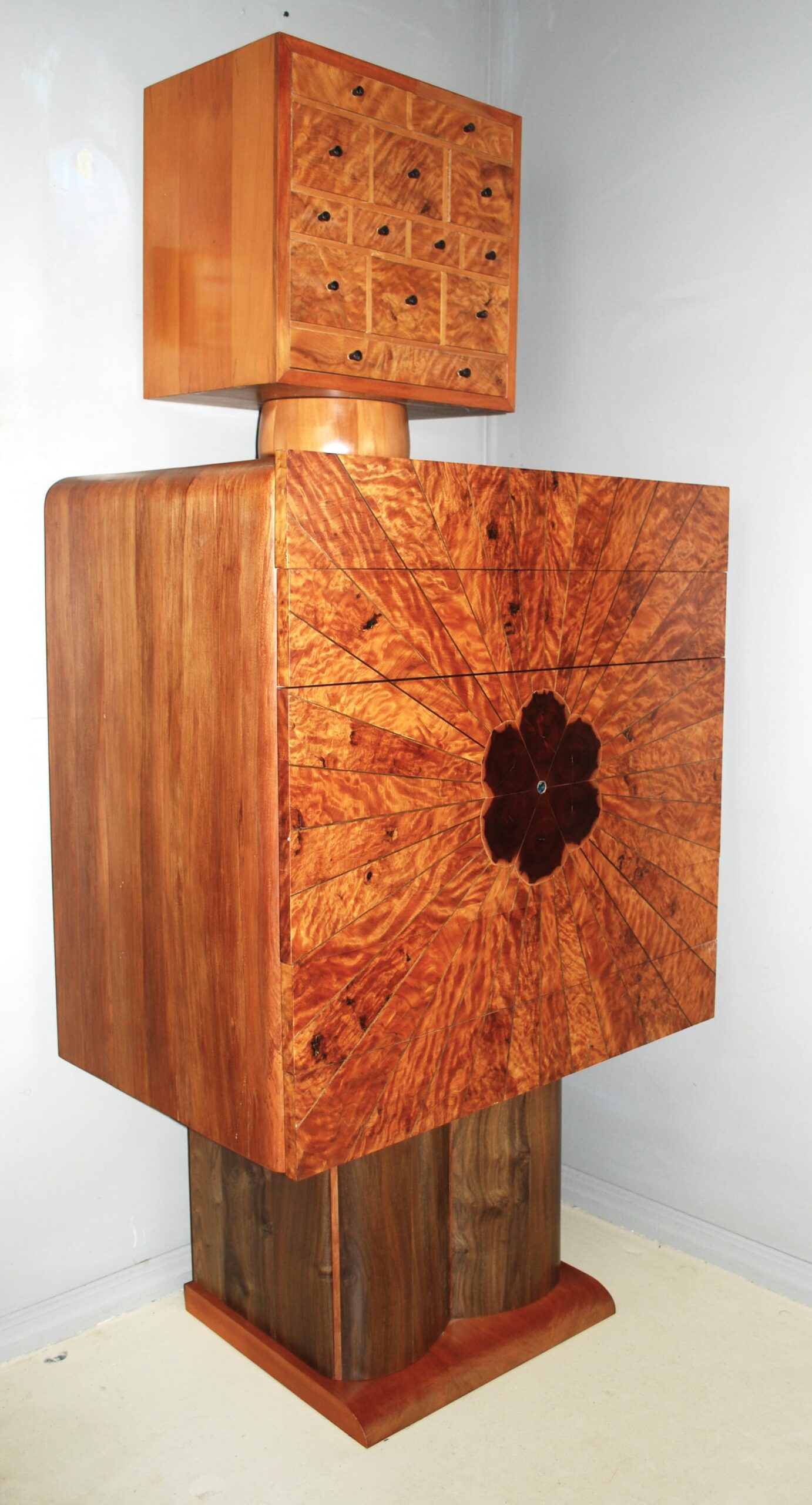
Henrys Gentleman’s Dresser
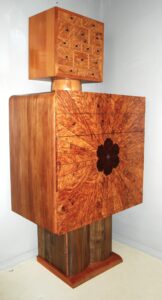
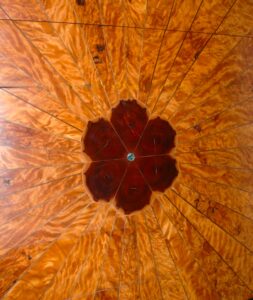
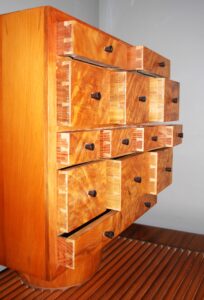

Made for my youngest son. The design originated from a sketch he did when he was five years old and wanted to help his dad design something. The form and details were refined over the years of its making so that it evoked the spirit of a person. The top a face, separated with a neck on a body featuring a Pink Ivory radiating heart sat on the legs and feet. Made in New Zealand timbers, burr Totara, Rimu, Matai. Puriri, Kauri, Pohutakawa. As well as Ebony handles with Macrocarpa and Cedar for the drawer boxes. The cabinet contains seven secret compartments. H 1800 x W 800 x D 530.
-
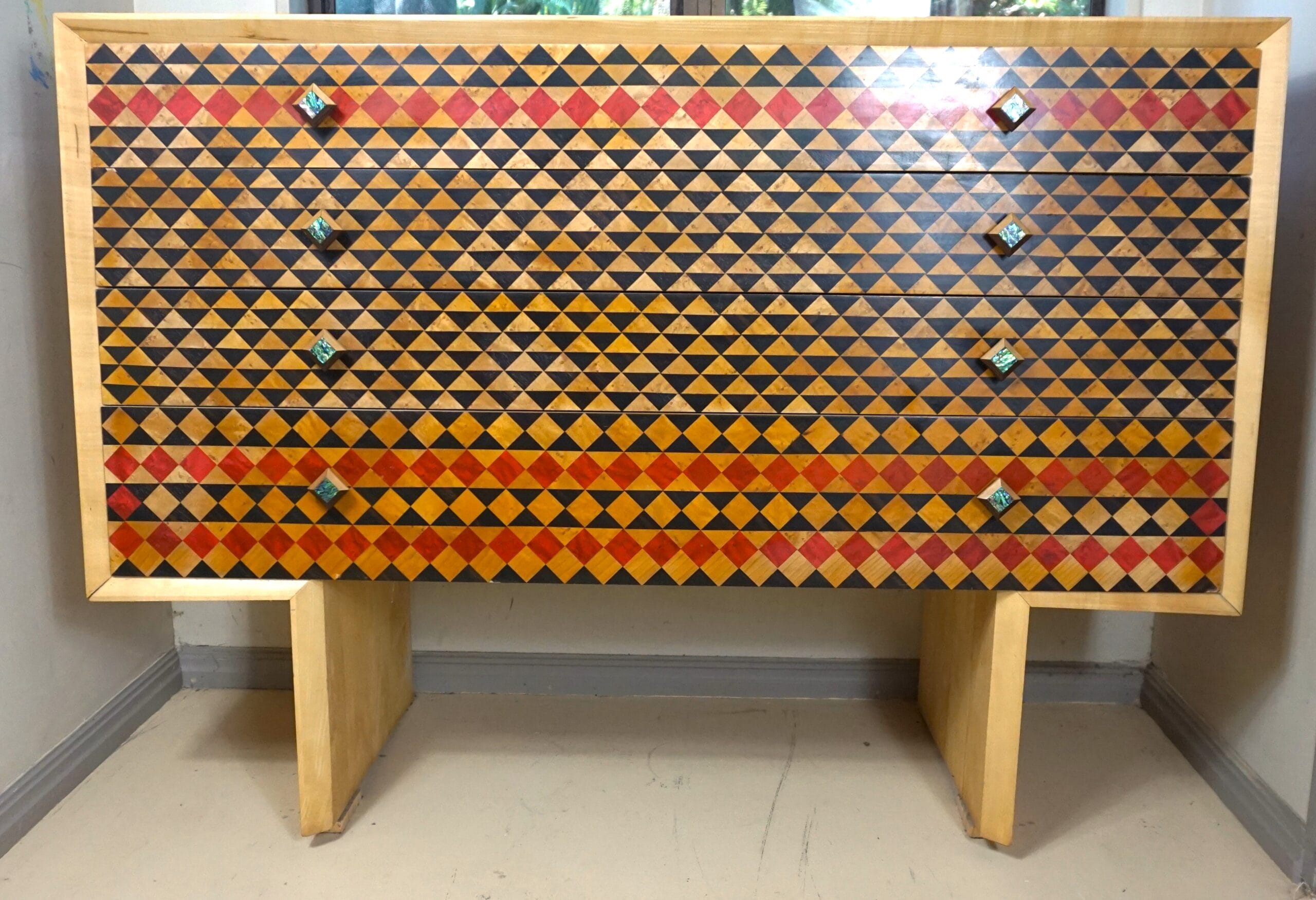
Taniko. Chest of drawers
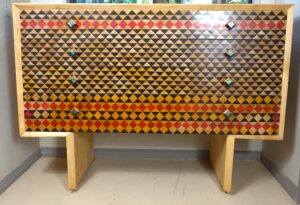
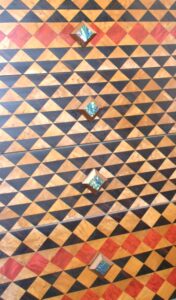
The design evokes the form of the Māori meeting hall. The pattern on the draw fronts are inspired by the belts ‘Taniko’ worn on traditional Māori grass skirts ‘Piupiu’. The carcass is made in solid Maple. The parquetry pattern is made from bird’s eye maple, red pigmented birds eye maple and ebony laid onto a Maple front. The handles have maple tops and wenge bottoms (giving a shadow illusion) with Paua centres. The dovetailed draw sides and base are made in cedar to give a lovely smell on opening the draw. L x 1200 x H x 930 x 500
-
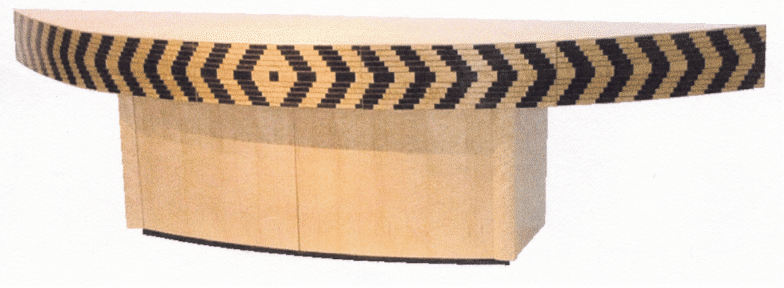
Parallel Lines. Sideboard
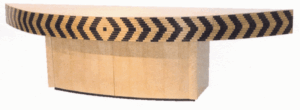
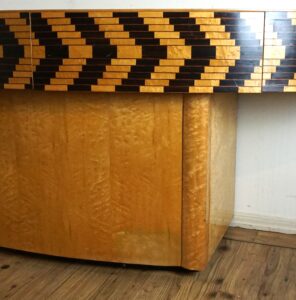

Designed for an exhibition of contemporary furniture at the Waiheke Island Gallery. The marquetry pattern is an interpretation of the traditional Café wall illusion. The cabinet is made from Maple and the base has Birdseye Maple doors. The top unit fascia is broken into includes three drawers and the fronts are veneered with Birdseye Maple and Ebony with Bubinga lines. L 2800 x W 600 x H 750
-
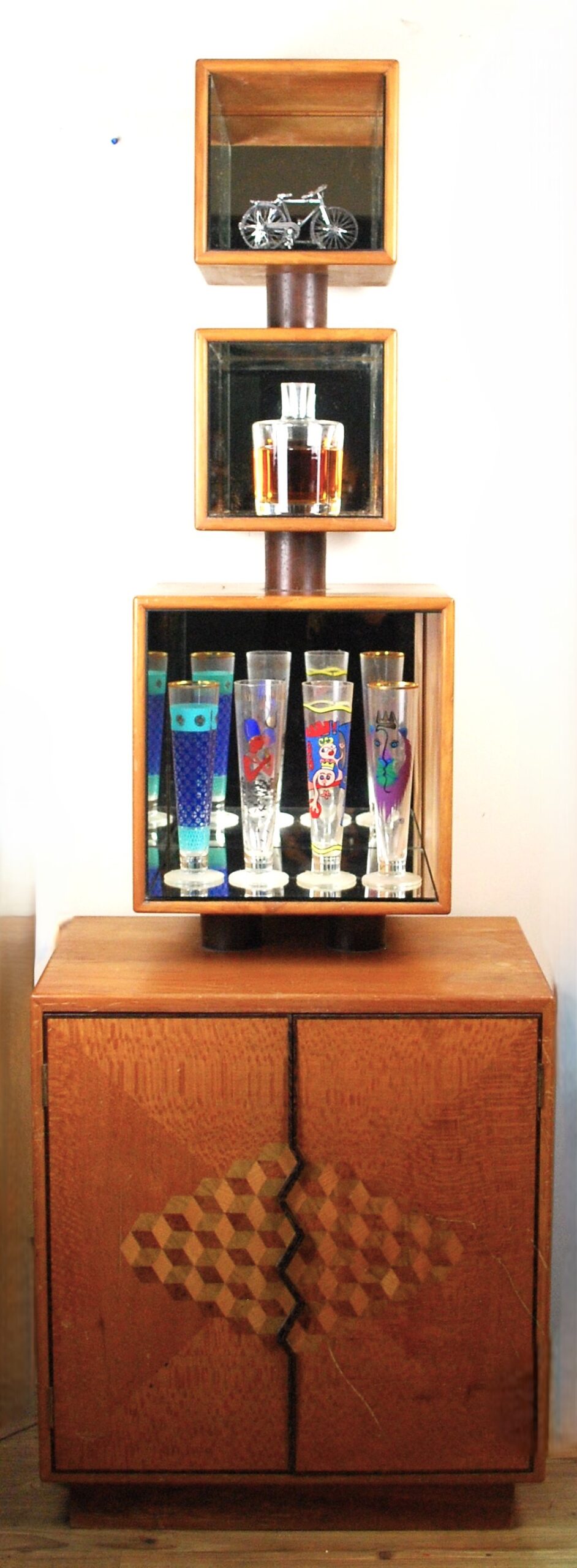
Louix’s cubes
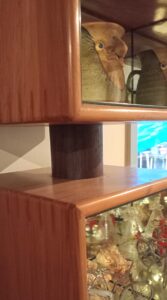


The cabinet was designed to function as a storage cupboard and for displaying objects. Each box is lined with mirror which increases a sense of depth and allows an all-round view of the objects on display. The cabinet boxes are made in Heart Rimu separated by turned Wenge posts. The marquetry doors on the base feature a marquetry pattern which is a traditional Louis XIV Cube design. The veneer surround is quartered Silky Oak, the pattern burr Ash and burr Elm and Ripple Sycamore. The Wenge boarder rises in the center to form the handles. H 1800 x W 620 x D 450
-

Optical Chequer



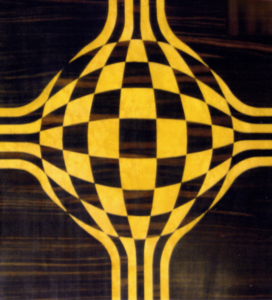
A tall cabinet designed to hold bottles and glasses. The marquetry pattern was inspired by seeing a large magnifying lens resting on a scribble which exaggerated and distorted the lines. Made in Maple and Ebony, the interior has adjustable shelves and the dovetailed draws have yellow cedar sides and bottoms. H 1800 x W 400 x D 400
-

Cutlery cabinet

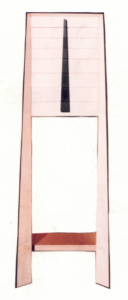
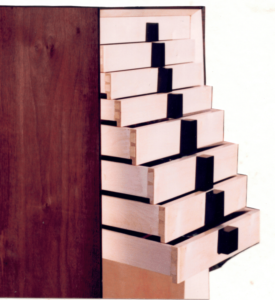
This piece was the last commission undertaken before emigrating to New Zealand. Made for a collector of contemporary British craft. The drawers are fitted to hold a collection of beautiful bespoke cutlery. The aesthetic of the design is intended to reflect a dynamic upward movement encapsulated in a pure heart. The cabinet carcass is veneered in English Walnut and Ripple Sycamore and the drawers ripple sycamore with cedar fittings for the cutlery and an Ebony handle. H 1750 x W 600 x D 400
-
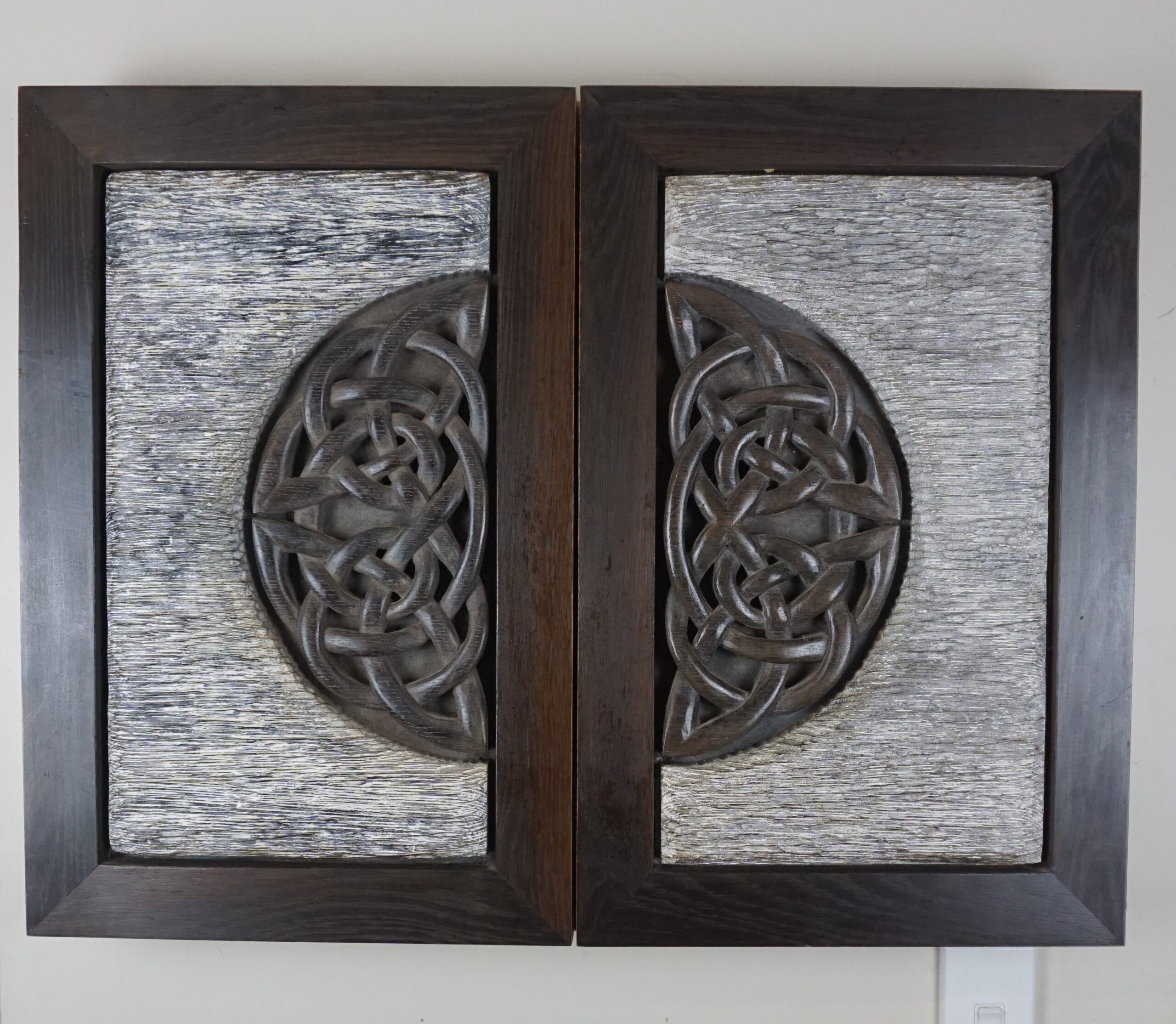
Knot of Life. Dartboard cabinet



The dartboard cabinet is made of solid Oak with through dovetails on the corners continued with the foor frames. The deep relief carved doors are based on a traditional Celtic Knot of Life pattern. The exterior is Ebonised and the carved surround is textured then finished with Limed Oak wax polish. L 800 x H 600 x D 120
-
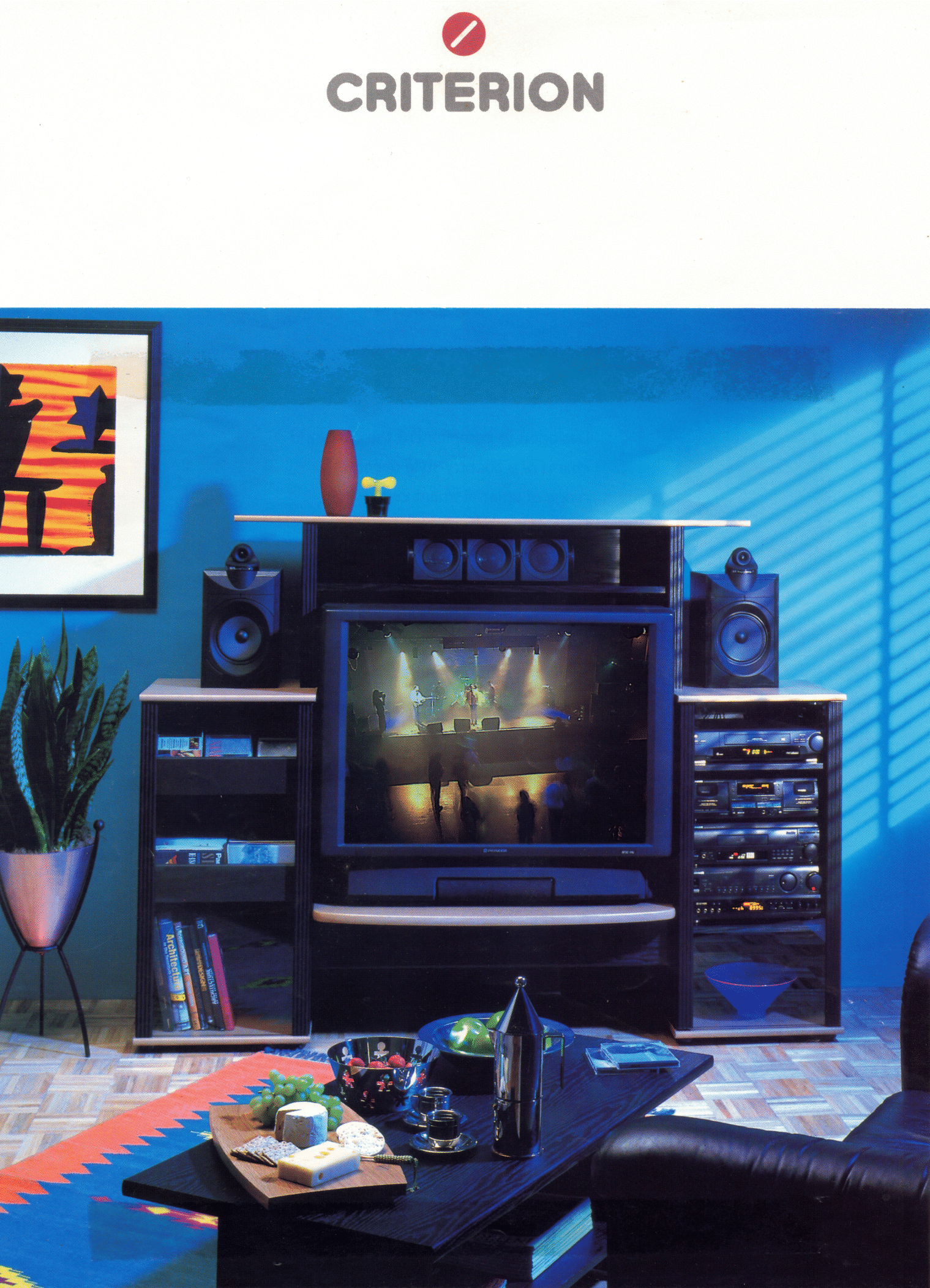
‘Ella’ Entertainment center
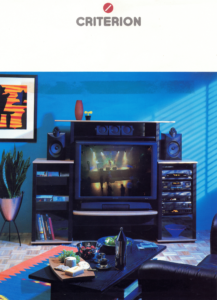
One of a large range of mass produced CKD (completely knock down) entertainment cabinets designed for Criterion Furniture. 1996
-
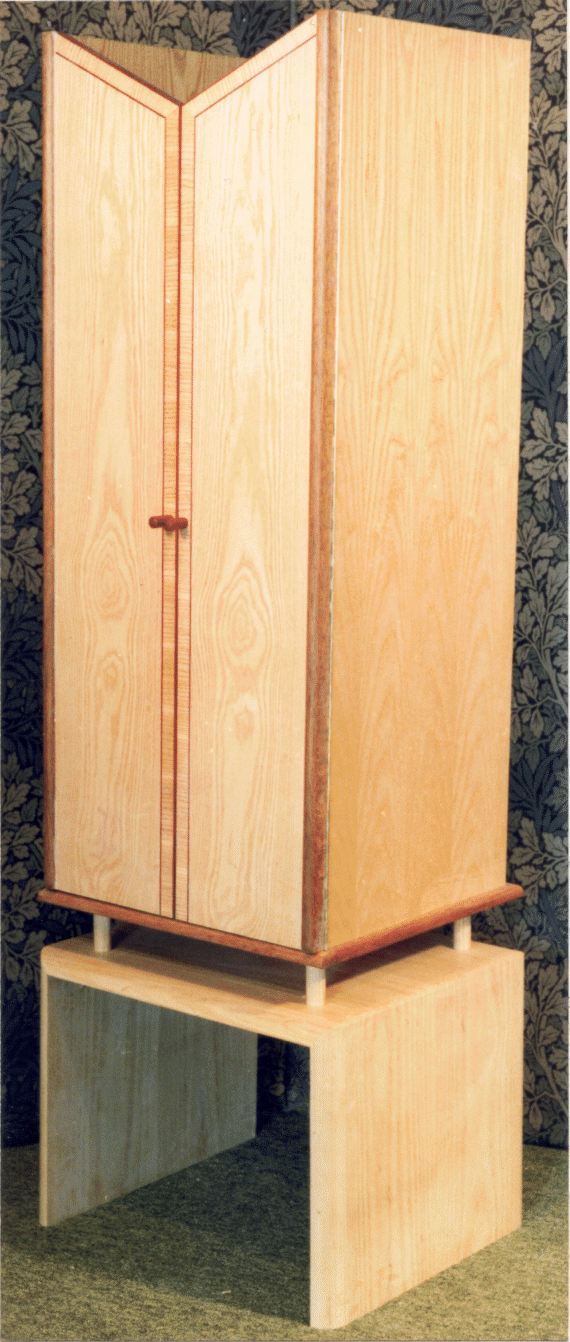
Collins & Envelope. Hi-Fi Cabinets

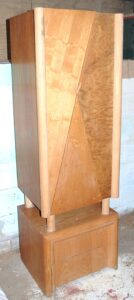
A range of HI-FI Cabinets that are based upon a standard carcass and base. The interior contains adjustable shelves and drawers and the base unit can also be fitted with drawers (shown on the ‘envelope’ design). The cabinets character can be changed significantly through the design of the doors, different plinths or bases. The two illustrated designs are made in American Ash.
The “Envelope” design uses three different types of Ash for the doors; crown cut, quarter sawn and burr.
The “Collins” design is inspired by a tailored detail from a couture dress that the original client loved. This is recreated with an edge moulding of cross grained Ash and a Padauk boarder within a crown Ash panel. H 1700 x W 500 x D 450
-
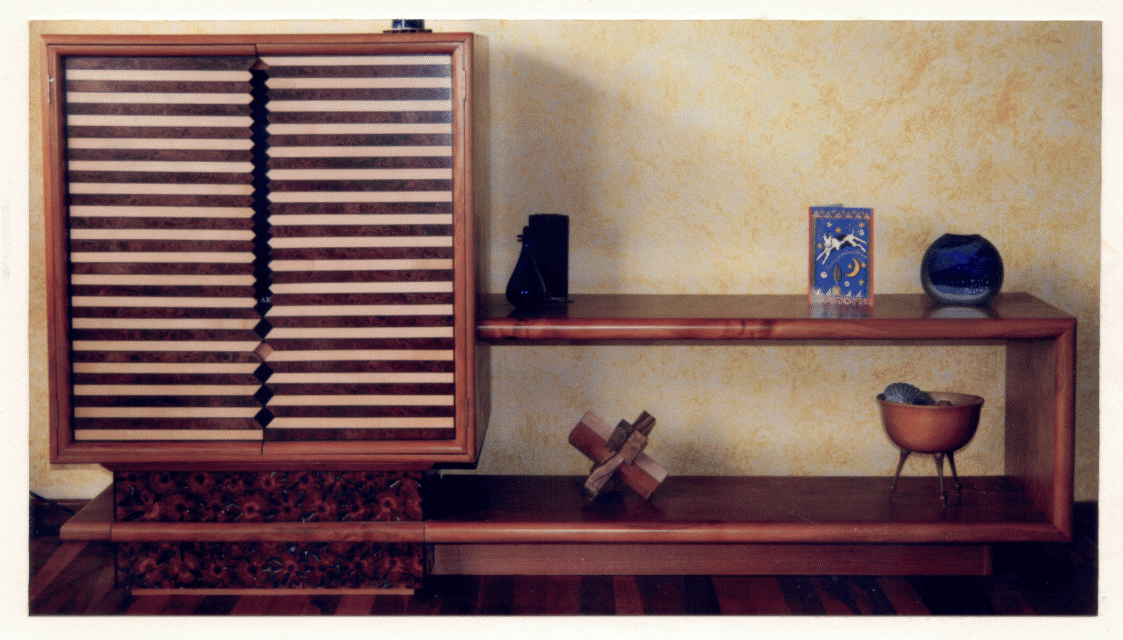
Test Card. TV cabinet
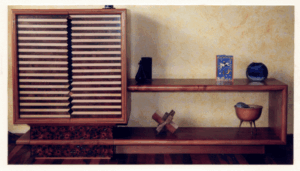
TV Cabinet set on a storage drawer base integrated with a display shelf. The door pattern was inspired by the interference lines on the TV screen. The carcass is made in heart Rimu and the doors are veneered in Sycamore and burr Walnut. The base draw box features a parquetry design of Australian Banksia nut slices. The shelf corners are through dovetailed. L 1800 x H 900 x D 600.
-

Balinese outdoor TV cabinet
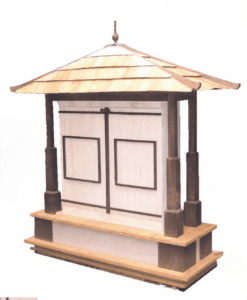
Commissioned for the TVNZ garden makeover show ‘Mucking in’ . Designed to fit a brief for a Balinese tropical themed garden in Kaikohi. The cabinet holds an outdoor TV and is made in Kwila and Cedar.
-

Chaston’s Corner

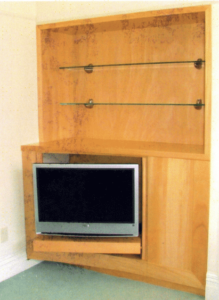
Designed to fit in the alcove of a large villas living room. This one-off cabinet was a response to a clients wish to have something more three dimensional hence the curved front. Made in Fijian Kauri with a hand made tambour door that reveals the TV mounted on a slide out shelf. The side cabinet is fitted with drawers for their DVD collection. Above the cabinet are adjustable shelves for displaying a collection or glass ceramics and collectors books. The top contains concealed lighting to highlight the display.
-
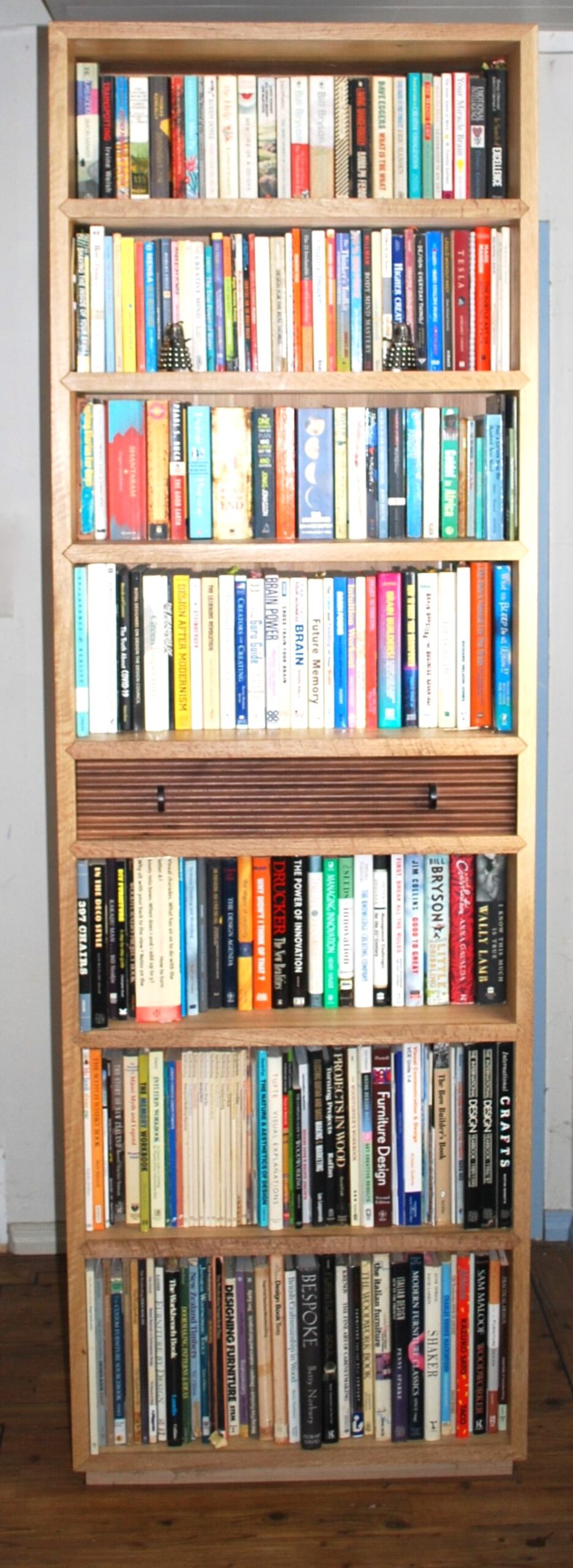
Birds Beak Bookcase

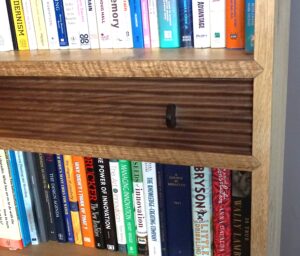
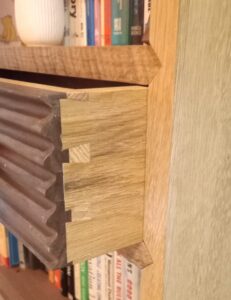
Made in Oak featuring a birds beak joint connecting the shelves to the sides. The traditional dovetailed construction draw has a scalloped walnut front with Puriri handles. L 2200 x W 700 x D 270
-

Elysium. Bookcase
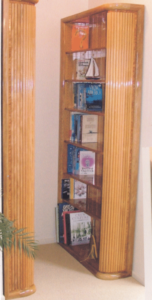
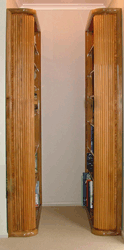

These bookcases were designed for a client with passion for all things nautical. The brief was to recreate the look of a luxury yacht interior and make the narrow space they are located feel large, accessible and inviting. The bookcase is made in Swamp Kauri, the reeded side panels are bordered by a burr Totara inlay and a heavy rounded Swamp Kauri frame. Finished with high gloss lacquer. H 2000 x W 800 x D 300
-
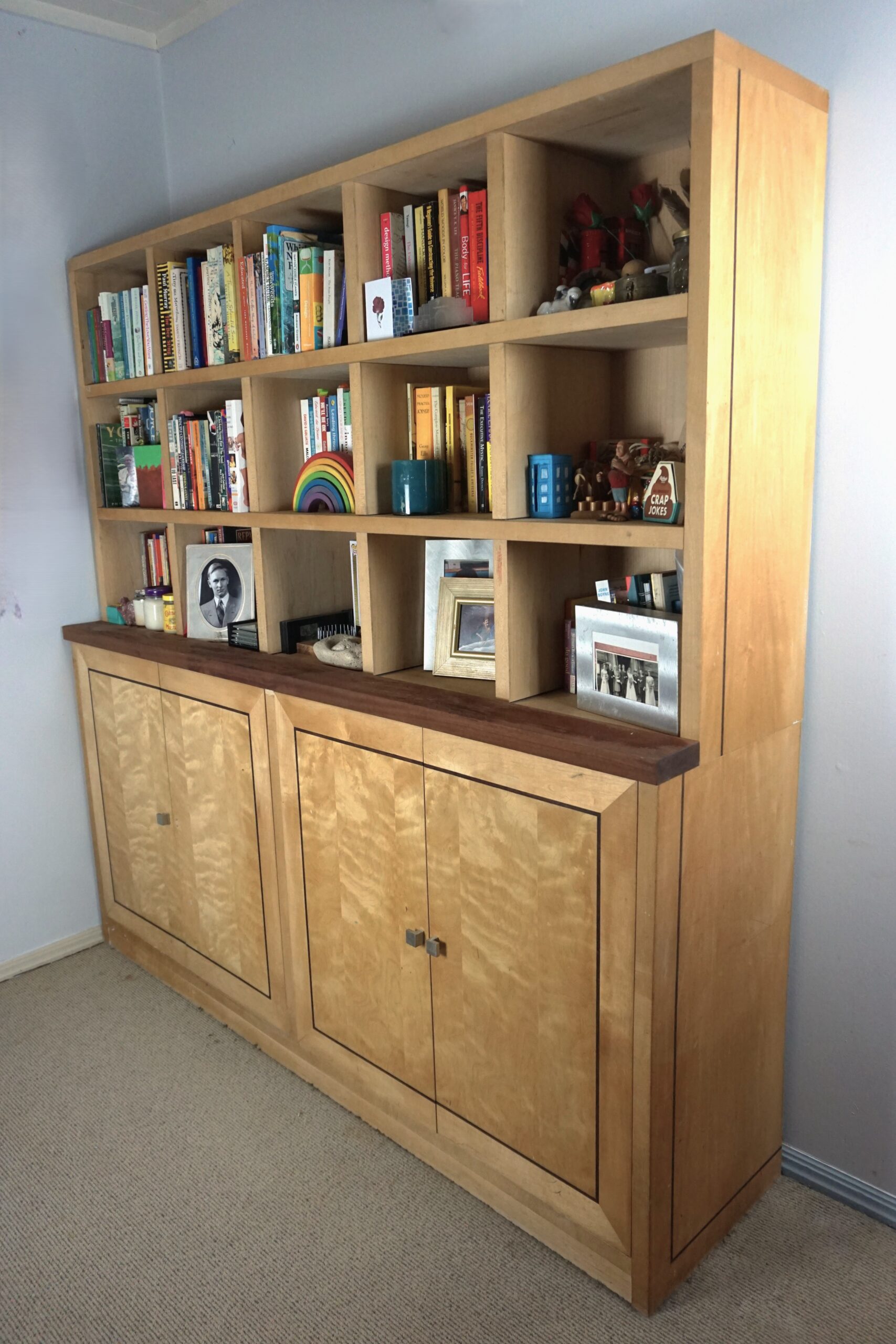
Bookcase and Cabinet
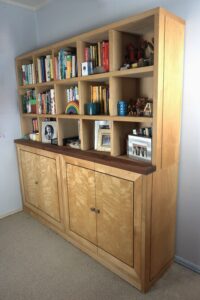
The carcass is made in Maple and the top of the base has a Jarrah top. The base doors have quilted Birch center panels with a wenge inlay. L 1800 x H 1800 x D 420
-
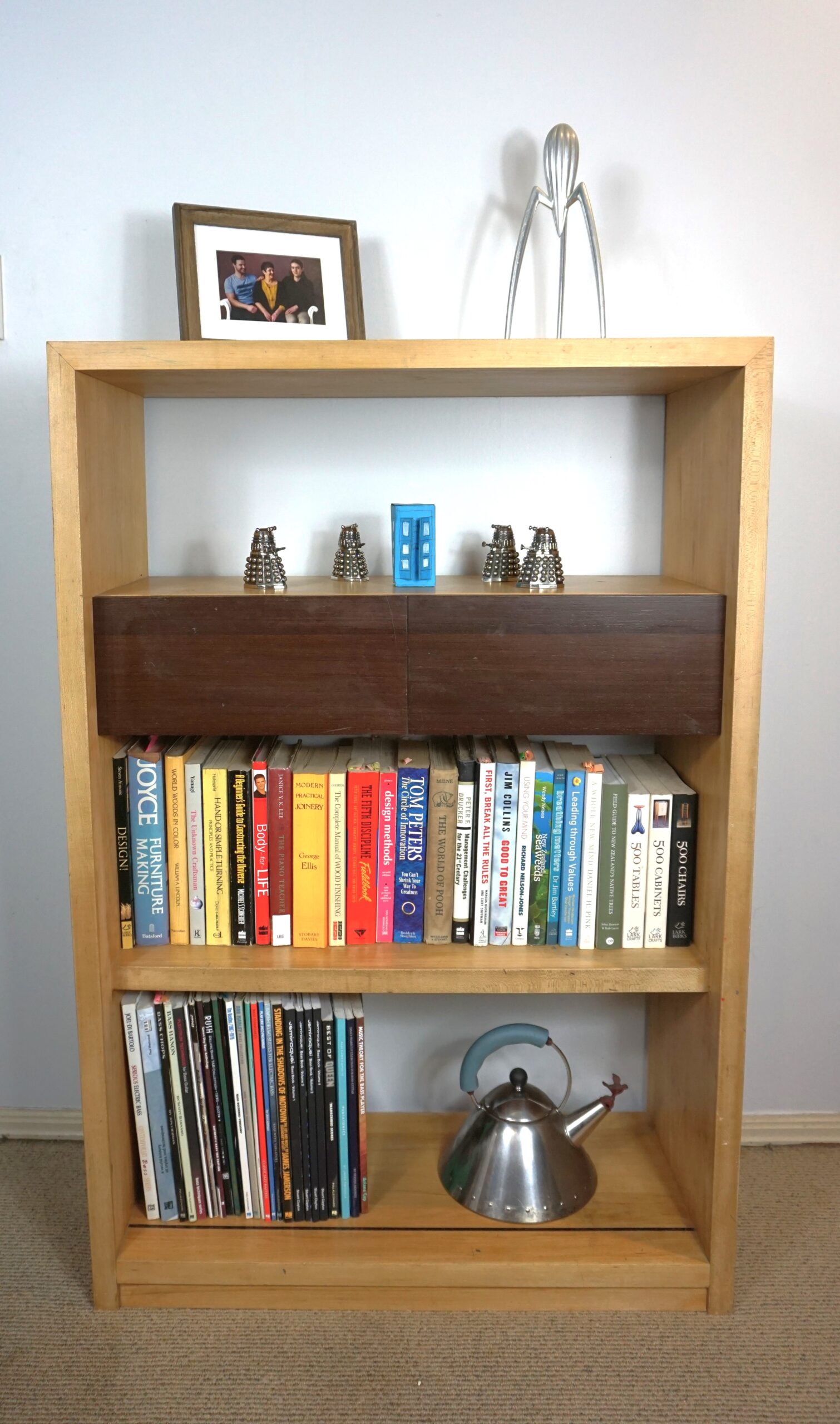
Bookcase
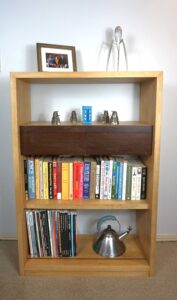
Made in Maple with two Wenge faced drawers that open from the bottom edge. H 1200 x 800 x D 320
-

Floating Shelf

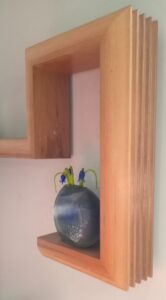
Designed as a wall feature to both display objects on the long shelf and feature a special object in the rectangular end. The shelf is made in scalloped walnut on the outside face and flat on the inside and attached to the wall with hidden fittings. L 1200 x H 500 x D 150
-
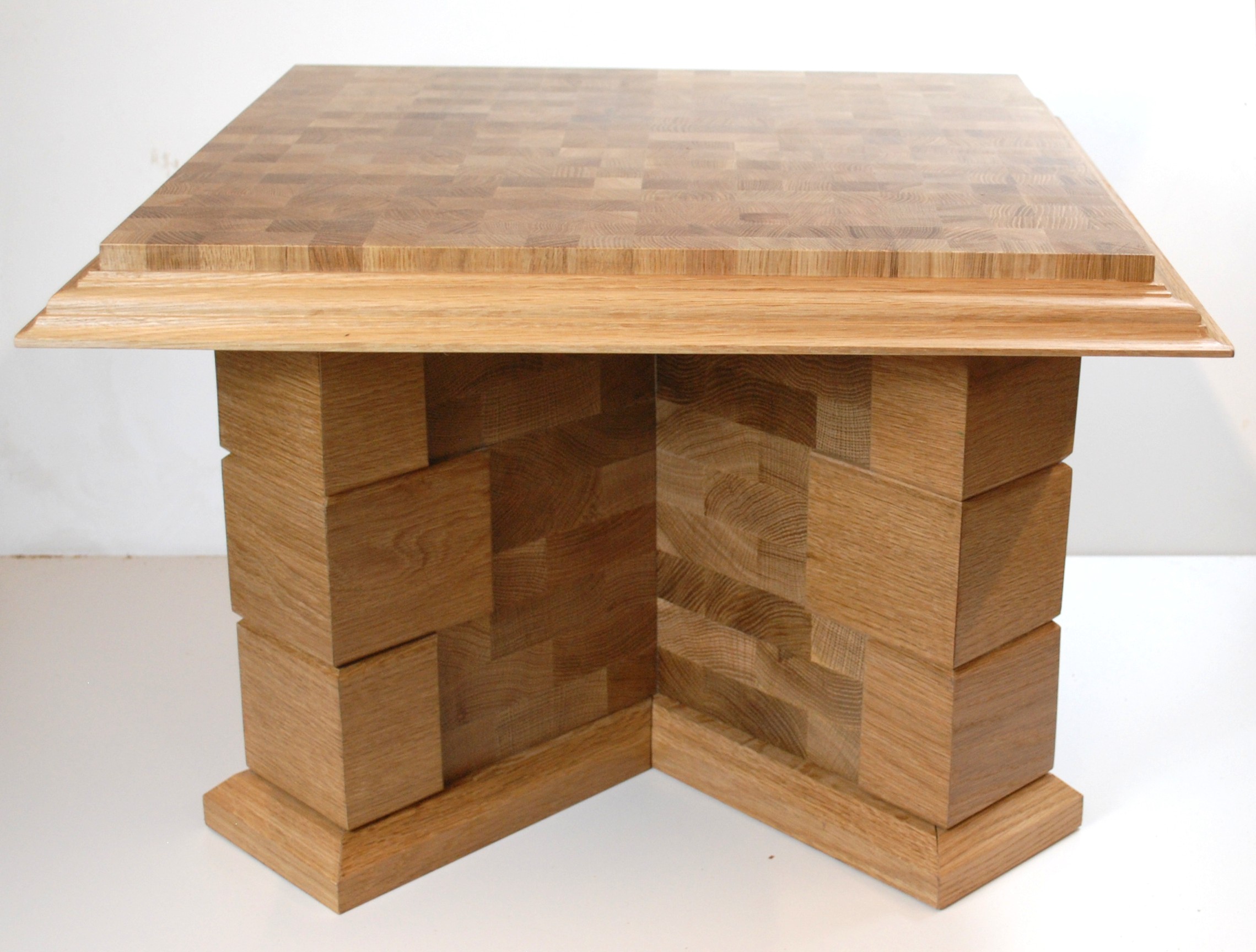
Cornerstone. Occasional table

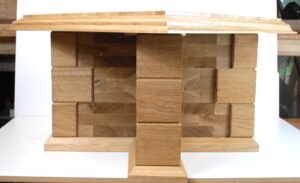
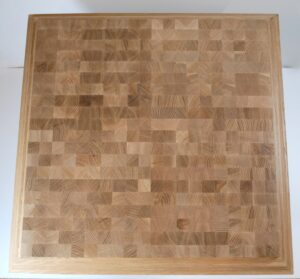
Inspired by the masonry details of Victorian civic buildings. The cornerstone table is built of offset laminated oak blocks with the end grain showing to emulate stone building techniques. The corner stones are made in quartersawn Oak to contrast with the masonry. The top is made from blocks of end grain Oak bordered with a traditional Cyma Recta moulding. The plinth has a bold champher. Size L 6 80 x W 680 x H 430
-

Kramer. Occasional table
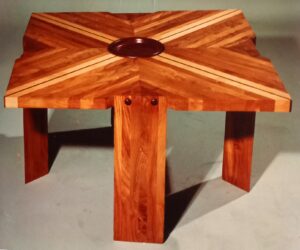
The design was inspired by the veins and structure of leaves. The choice of Elm with its dramatic grain pattern is contrasted with the plain, light cream coloured Sycamore central stripe and Rosewood pin-line. This draws the eye to the center where a turned bowl can be used to hold a plant. The legs are fixed to the top and pined with rosewood dowels. L 800 x W 800 x H 400
-

Weta Chair
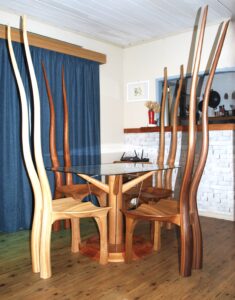

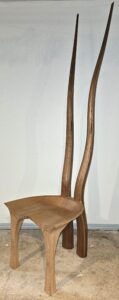
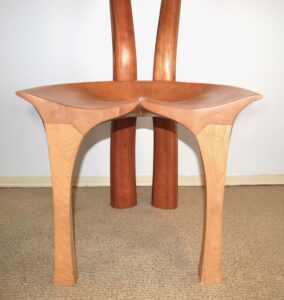
The end result of a lot of research into making a very comfortable chair. Inspired by the amazing insect the New Zealand tree Weta. The tall back legs evoke their loooonnng antennae, the seat and front legs capture the spiky shape of the head and legs.
The back legs are laminated from tapered strips and shaped by hand as is the carved seat. The chairs can be made from a wide range of timbers both a single species and or contrasting seat/back legs. The chairs are finished in Danish oil. H 1800 x W 520 x D 600.
Ash, Cherry and Maple, Walnut and Oak chairs are shown
-
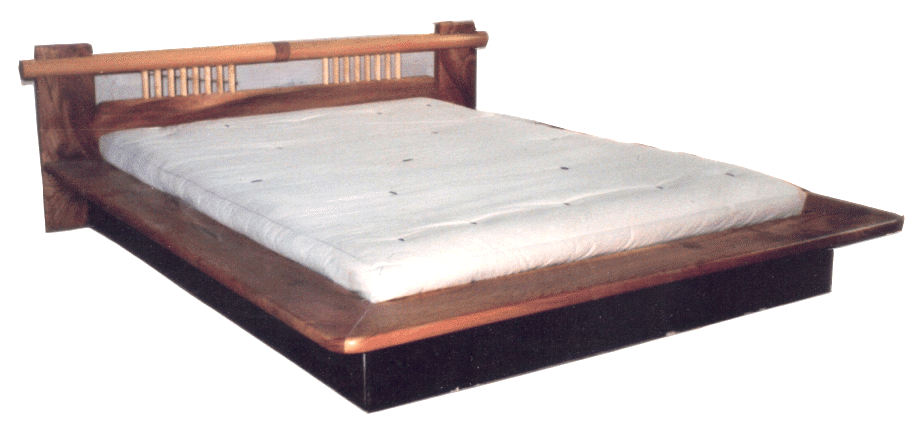
Futon bed
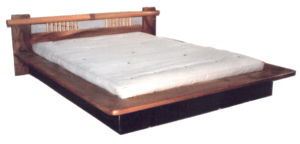


Design inspired by traditional Japanese interiors to accommodate a futon mattress. Made in Elm with a Cherry top rail, Sycamore posts wedged with Walnut as the head board detail. L 2000 x W 1800 x H 600
-
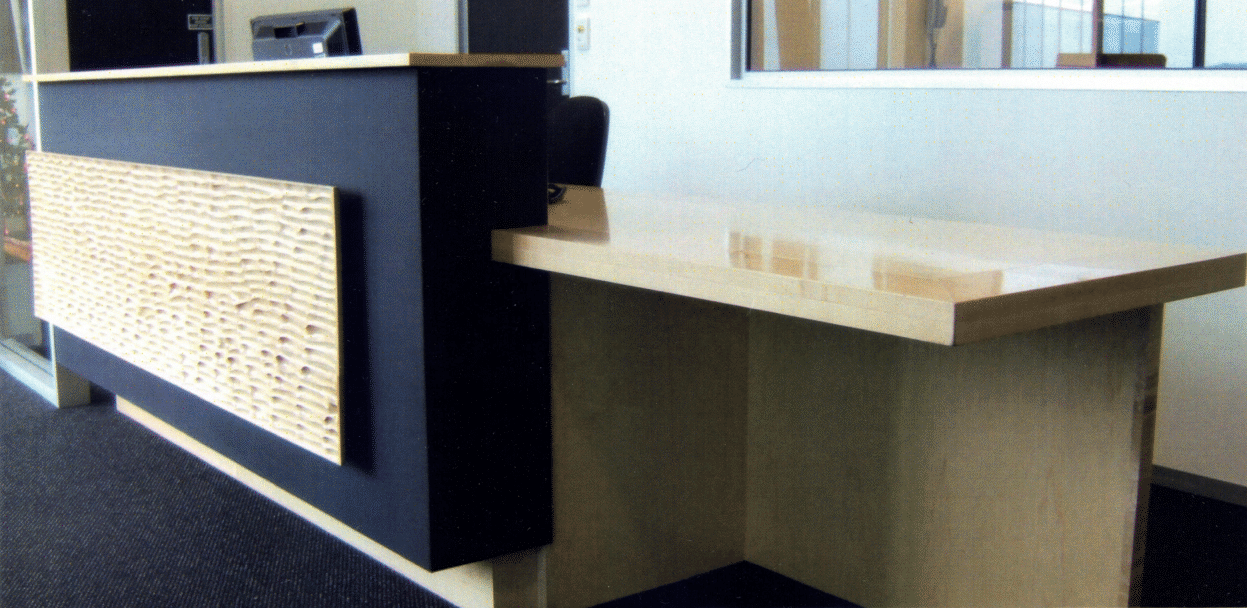
Walkworth medical center.
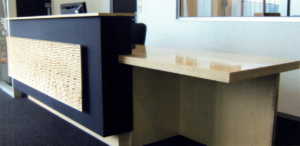
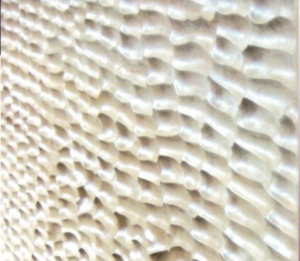
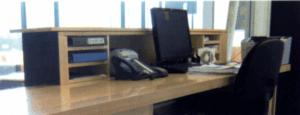
Commissioned for a specialist medical center in Walkworth. The feature panel was inspired by the ripple pattern left in the sand when the tide goes out on a local beach. Made in Maple and painted wood.
-
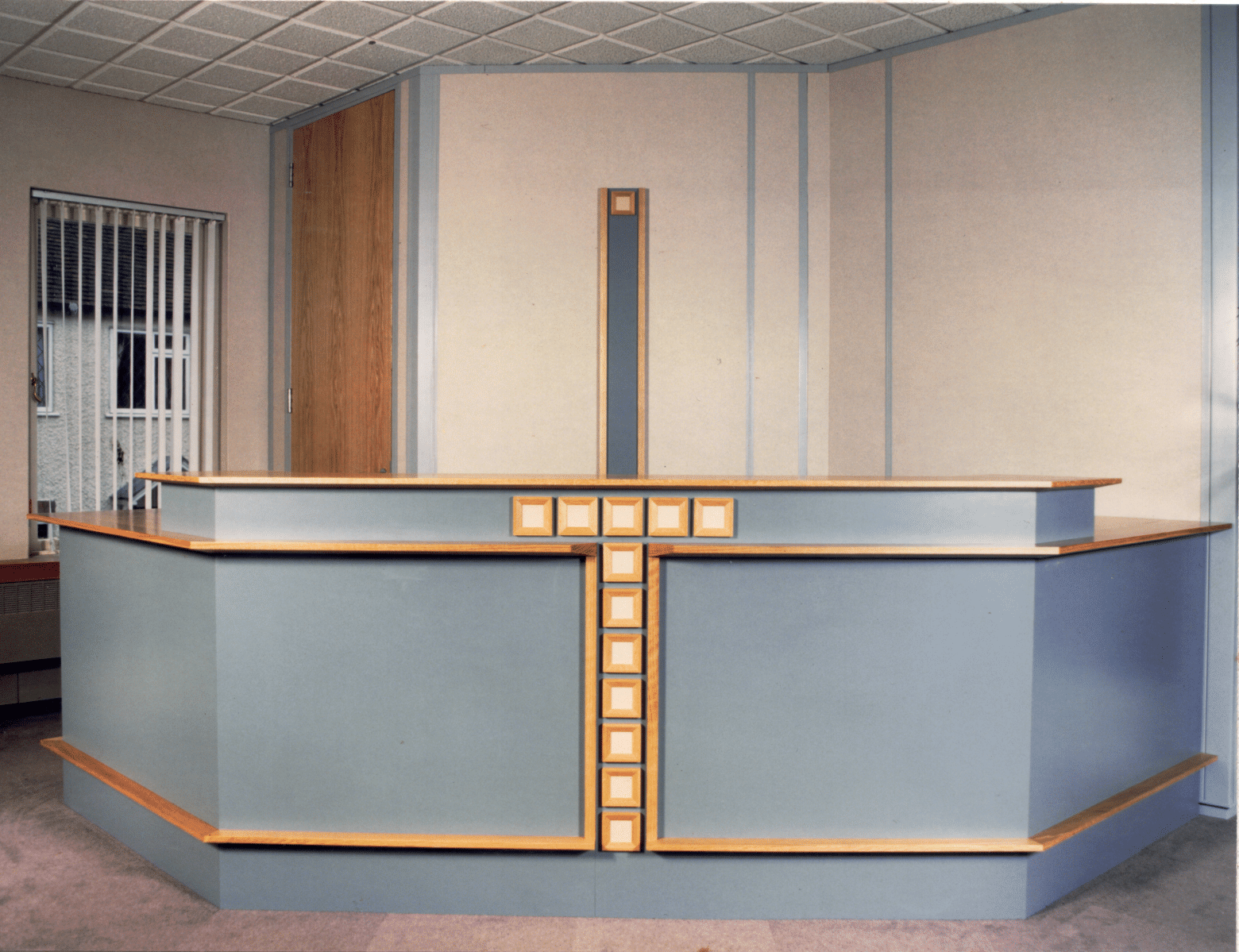
Grosvenor Page – reception desk
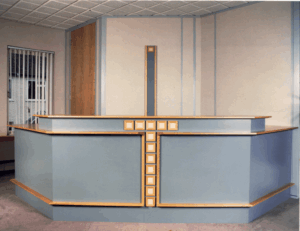
Designed at business design group UK for a Henley based recruitment consultants.
-

Pradeep’s kitchen
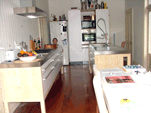


A traditional Ponsonby villas space was converted into a large kitchen and dining area. The client wanted a clean simple space yet retaining an element of craftsmanship. The kitchen cabinets are made in bleached and limed Oak. The long bench cabinets have deep drawers, the top has a custom stainless steel surface, the end wall unit holds the fridge. A separate mobile chopping block was made from end grain Oak blocks. The walls are white and the floor polished Matai.
-
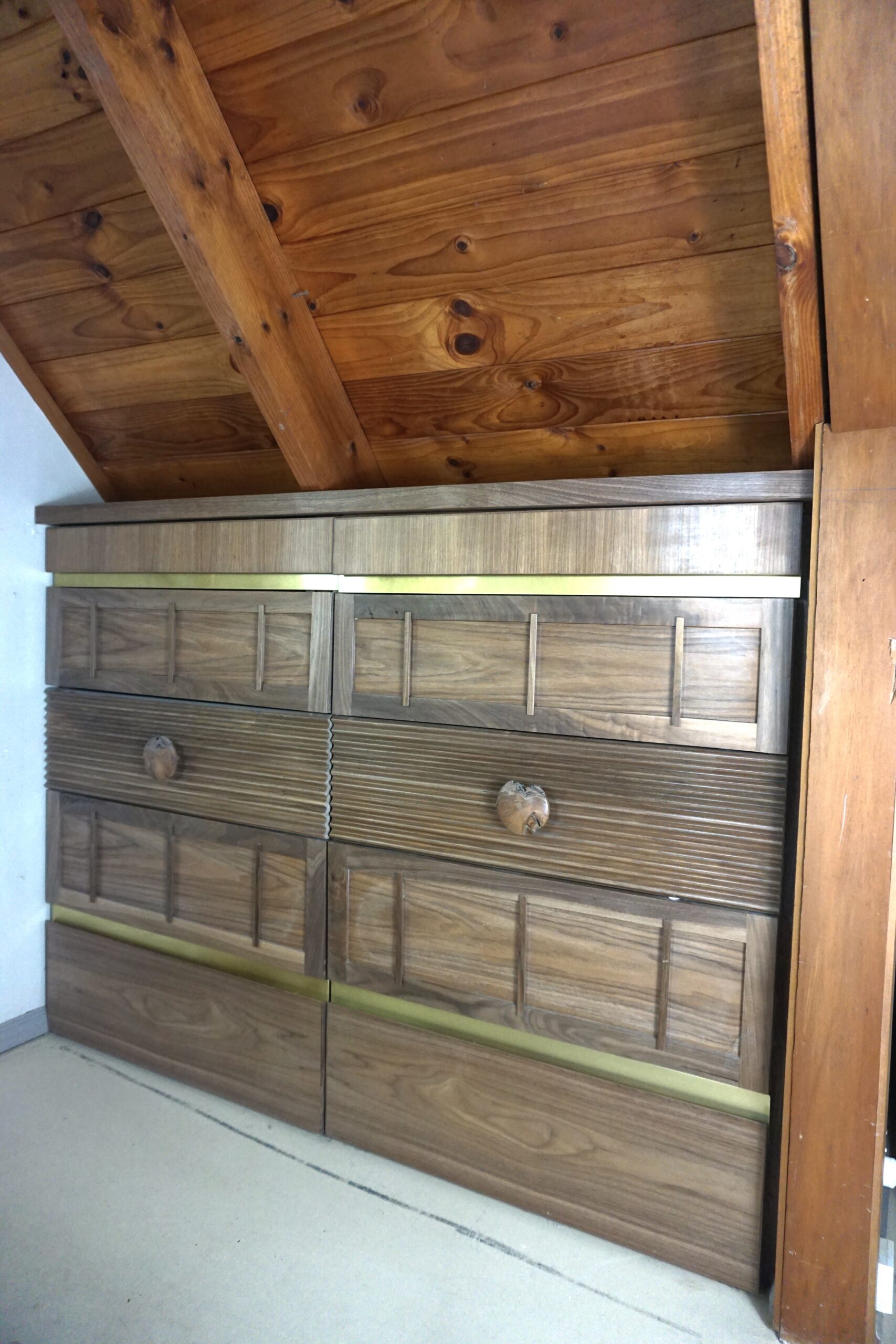
Bedroom Storage drawers

Designed to maximise a space created by a steeply pitched roof that left a lot of unusable space. This American Walnut cabinet is fitted with drawers of increasing depth. The faces are all made featuring different patterns and styles from an exploitation of grain types to frames and scalloped solid broken by polished brass strips.
-
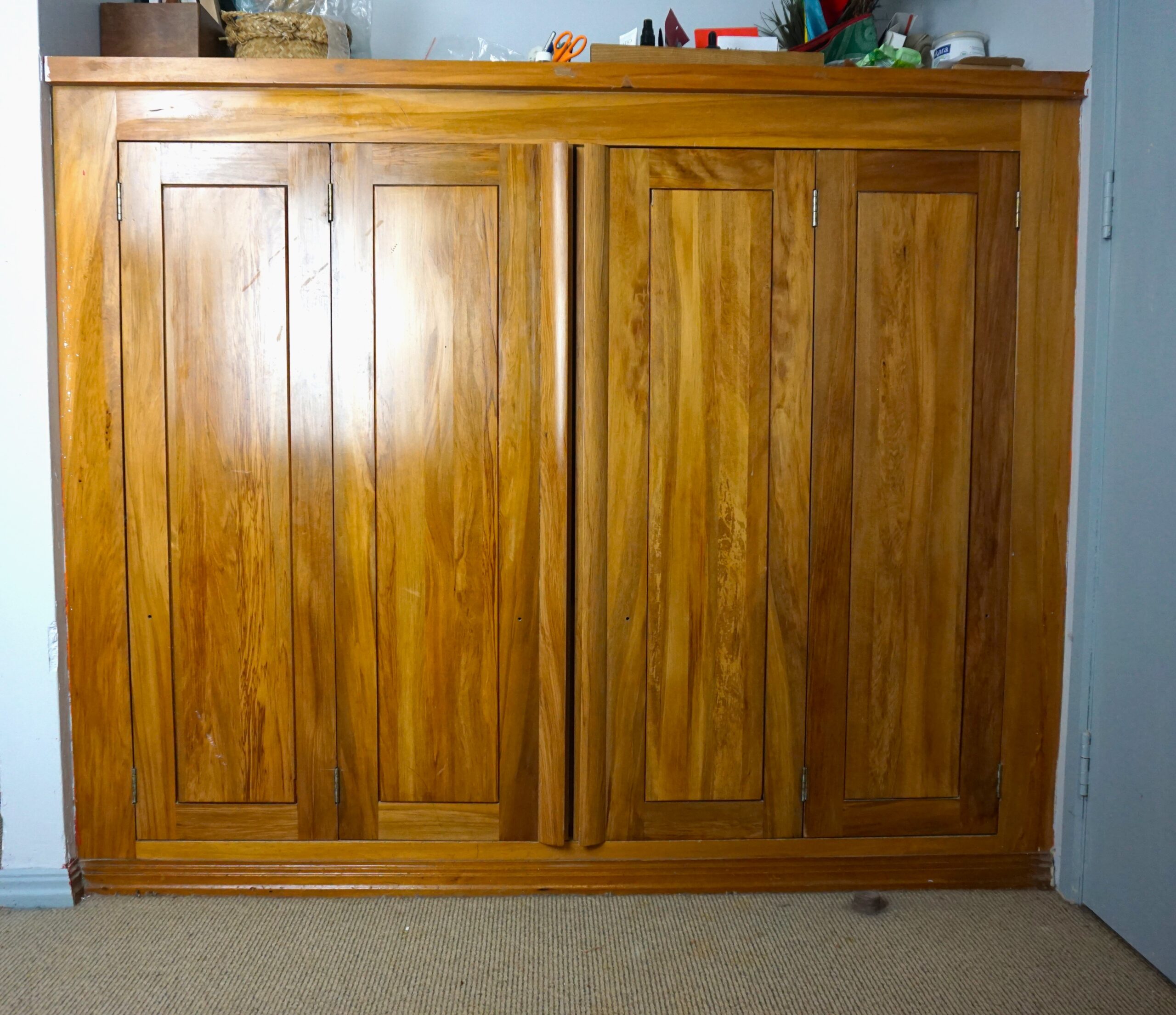
Fitted cabinet with internal drawers
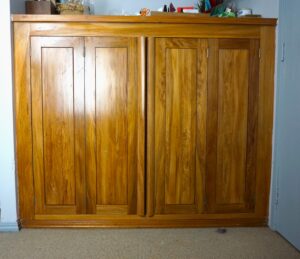
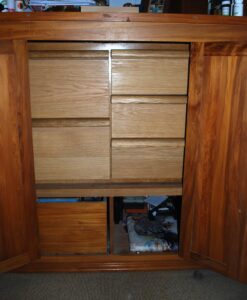
The pair of Bi-fold Rimu doors are panelled and have a full-length central handle. The internal drawers are Oak.
-

Doors.
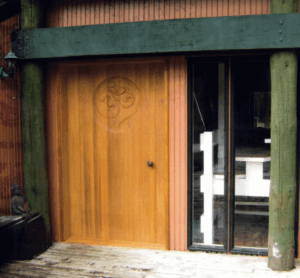
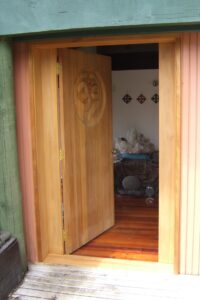

The Exterior door was designed for a client who were very involved with spiritual activities and wanted a carved symbol of the OHM.
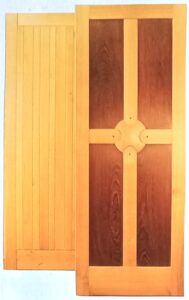
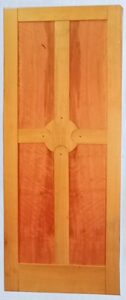

Oak and Wenge Oak and Myrtle Oak and Indian Rosewood
The interior doors were made for a barn conversion. The client wanted the door style to be modern with an essence of traditional fielded panel doors. Each of the four panels in the fifteen doors had to be a different timber chosen from the continents and countries they had visited. The frames are English Oak. The panels on the outside displayed the feature timber and the inside featured an Oak batten construction.
-

Battlefield. Games board and box

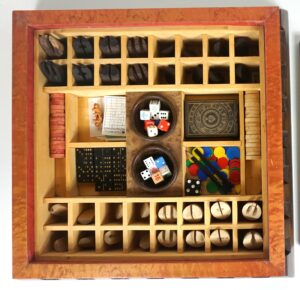
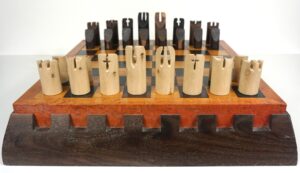
Marquetry chess and backgammon boards in red birds-eye Maple, ripple Sycamore, burr Ash, with a Macassar Ebony boarder. The Yellow Cedar interior compartments hold the Holly and Ebony turned and carved chess pieces, backgammon counters, playing cards and dominos etc. Turned Elm bowls set in a burr Elm panel hold the different types of dice.
-
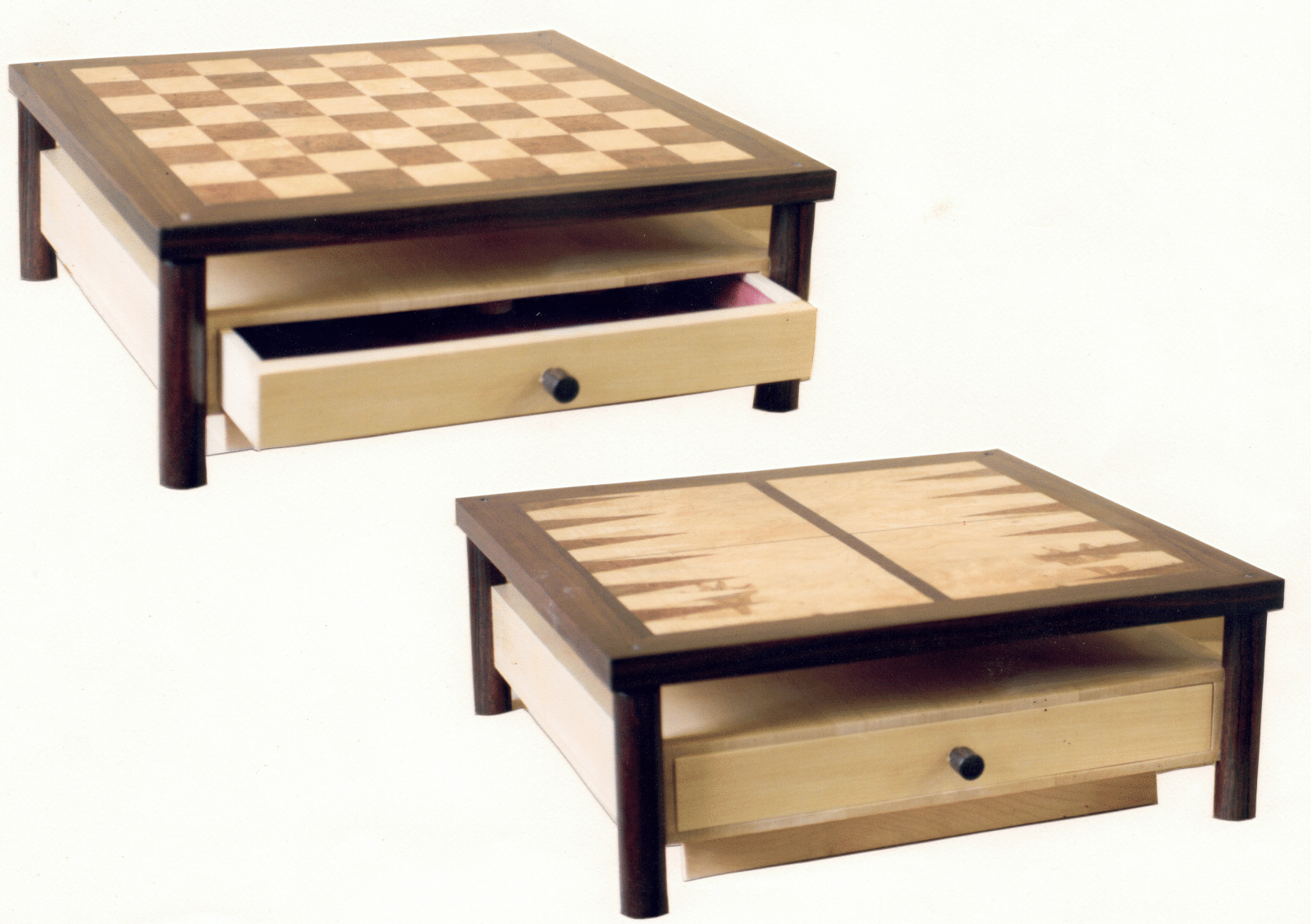
Checkmate. Games box
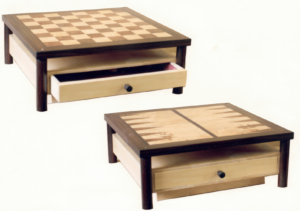
A Chess and Backgammon board set upon a draw to hold the pieces. Made with Blackwood legs and a Sycamore box. The marquetry games boards are Burr Ash, Walnut and Ripple Sycamore.
-

Perspective. Wine box
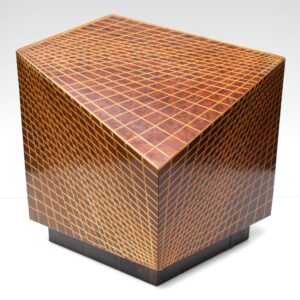

Presentation container for a bottle of wine. Inspired by a op-art painting by Mary Henry. Each face is a marquetry pattern made from different Burr timbers; Thuya, Oak, Elm, Walnut, Ash, with Maple lines mounted on a base of Ebony and Zebrano.
-
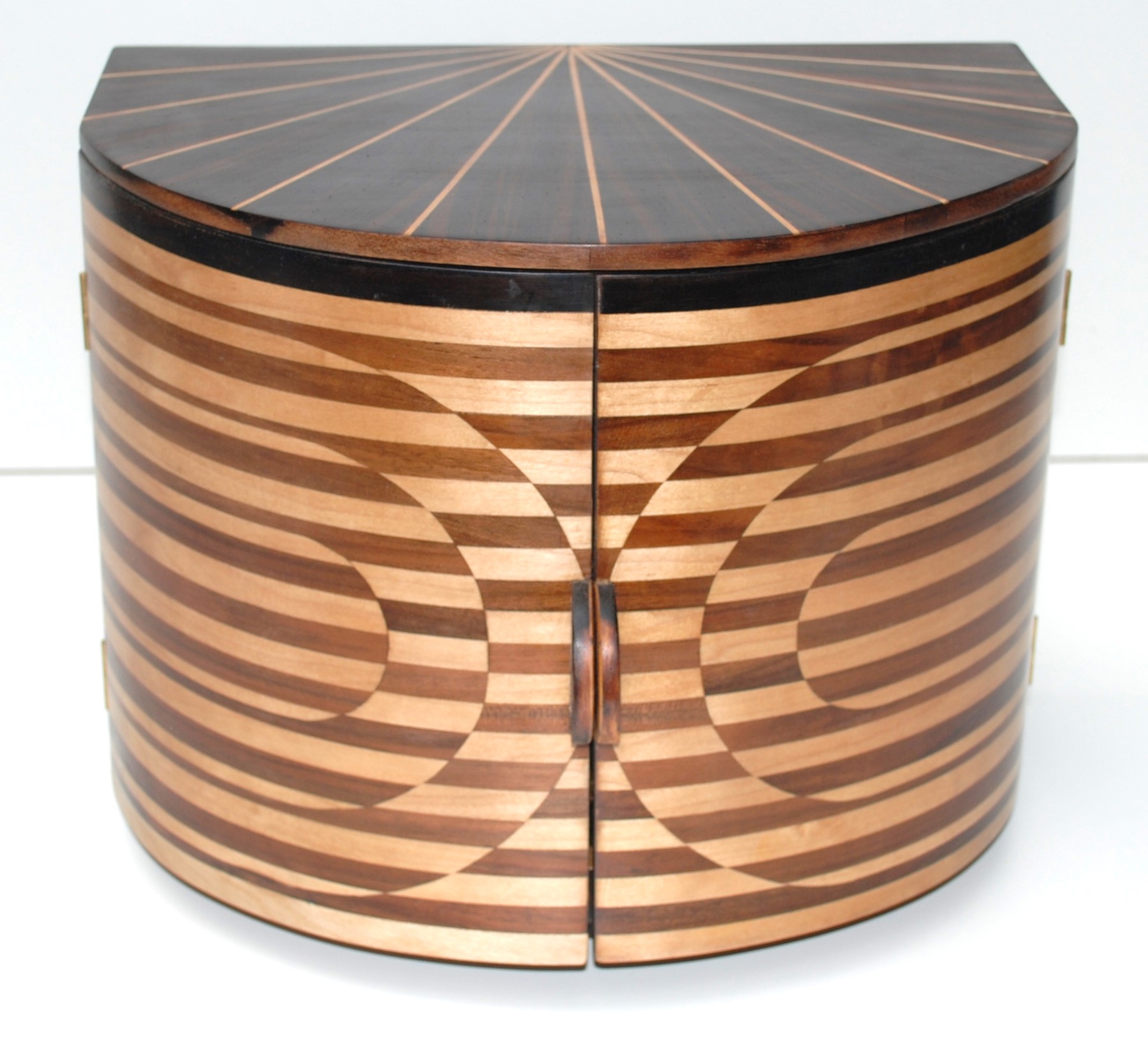
Decanter box
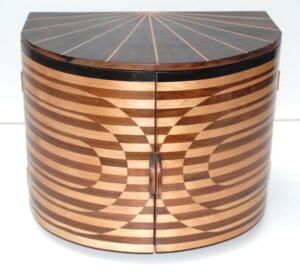

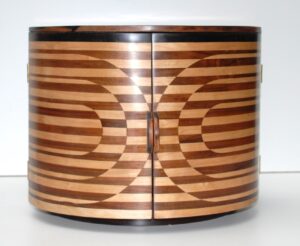
A box made as a 21st birthday gift to hold a whisky decanter. The outside design of the doors is based on the letter H for the clients name. The radial pattern on the top is Macassar Ebony. The parquetry letter H on the doors is mirrored on the inside. The interior ‘floor and roof’ has a chequer pattern and the walls are book matched quilted Oak panels.
-
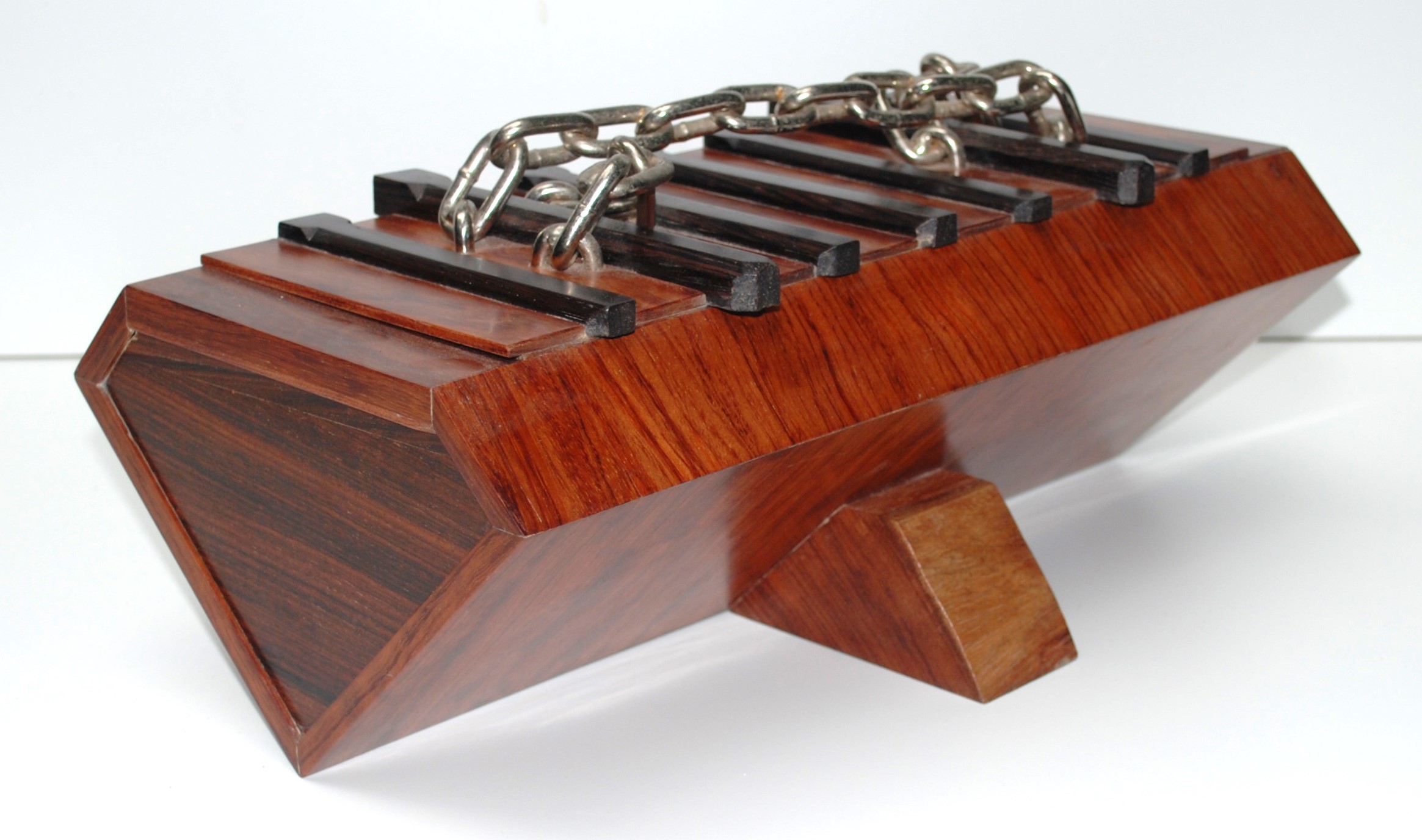
Suffragette. Jewelry box

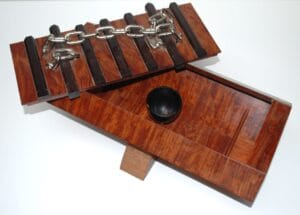
Designed for an exhibition celebrating the New Zealand centenary of the suffragette movement. The design is inspired by the well-known trope of being chained to railings. The choice of materials is Bubinga for the box because of the deep red colour, rosewood for the ends, the interior contains a blackwood bowl which lifts up to reveal a hidden space and also two hidden spaces in the side blocks. L 410 x W 210 x H 180
-
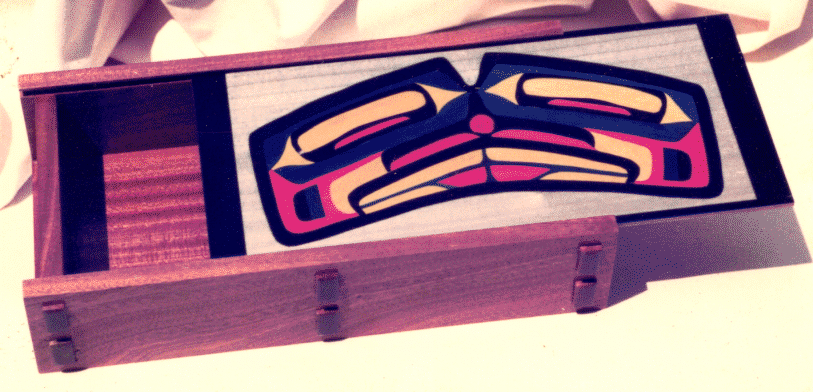
Jewelry Boxes
Canada. Made in remembrance of a daughter that emigrated to Vancouver. Designed to hold Lace bobbins. Construction inspired by log cabins and the marquetry lid by native west coast Indian art.
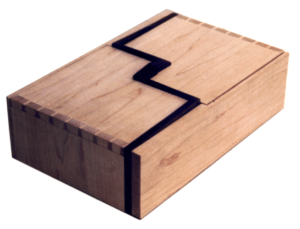
Butterfly. Made in birch with a walnut line that forms the handle. The lid which feature dovetails and opens from the center. The interior is lined with padded silk.
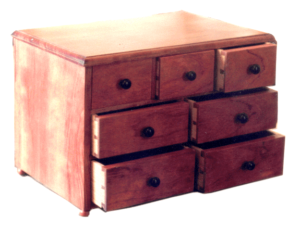
Treasure chest. Designed for a client who wanted a traditional chest of drawers for her daughter. Made in Bubinga with Oak draw sides, cedar bottoms and ebony handles.
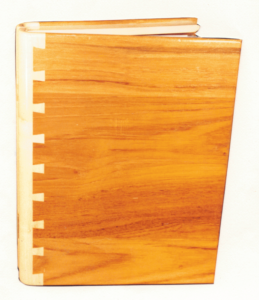
Portfolio case. Designed to present a portfolio of work held in file sleaves. Made in Teak and Sycamore featuring dovetail joints.
-

Spoons
Hand carved wooden spoons. chip-carved and plain; Cooking spoons, serving spoons, eating spoons, sundae spoons
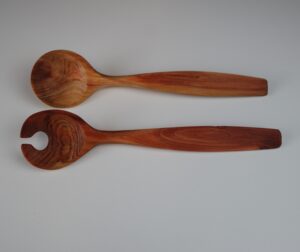

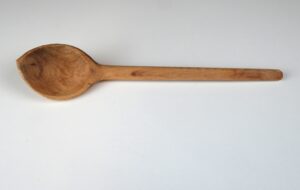
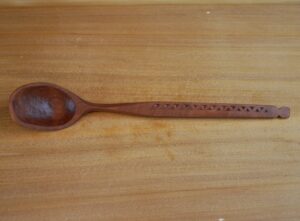
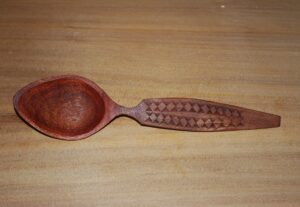
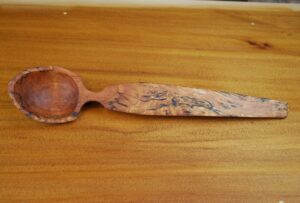
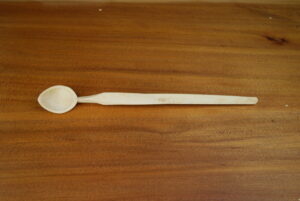
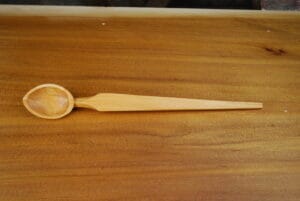
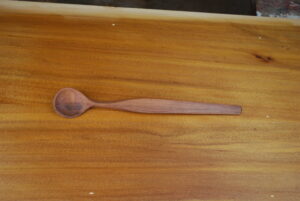
Hand carved wooden spoons. chip-carved and plain; Cooking spoons, serving spoons, eating spoons, sundae spoons
-
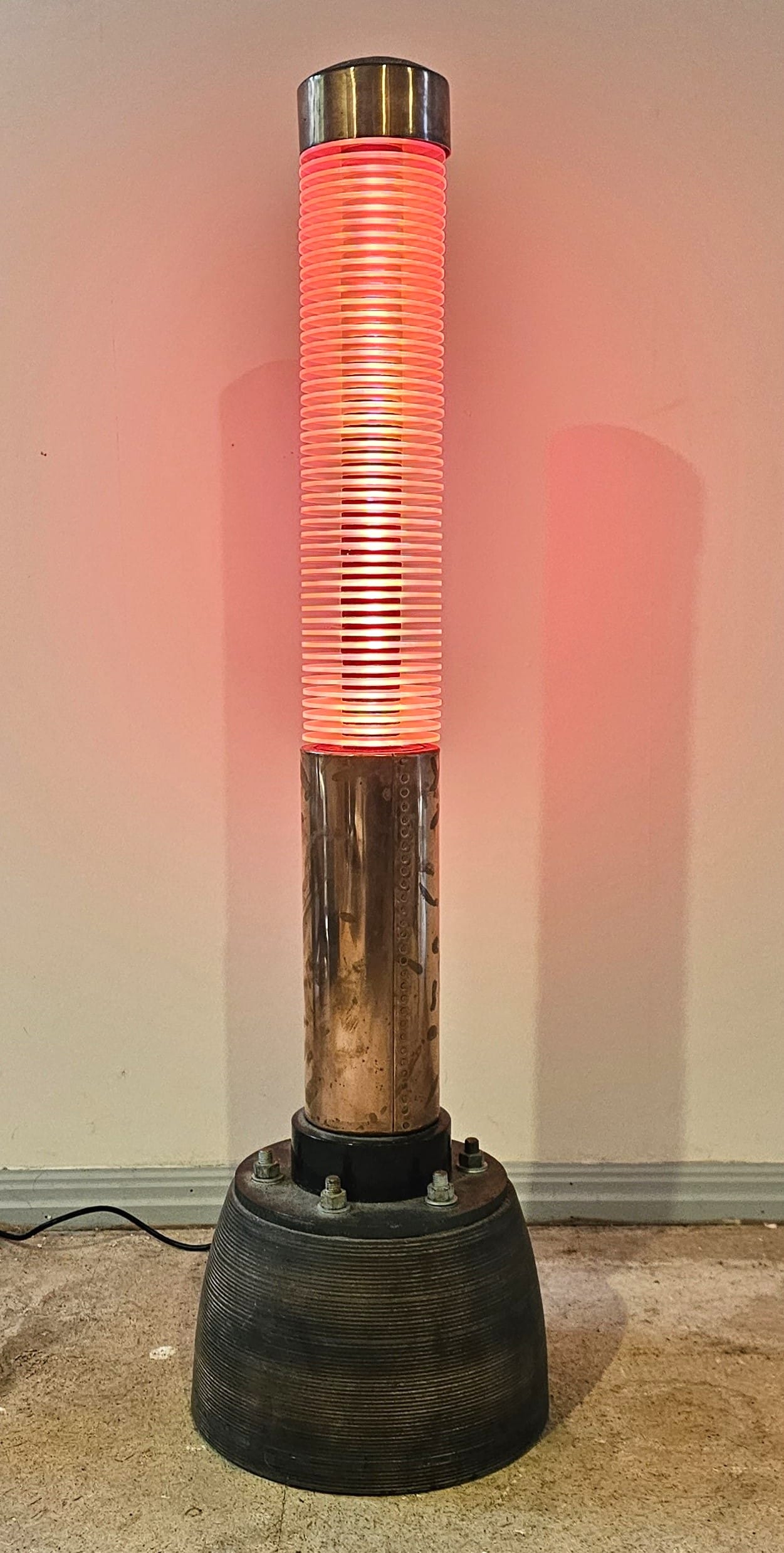
Radiant. Floor light
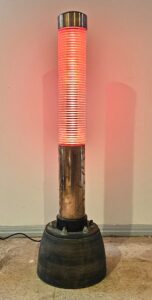


Decorative light. The design in intended to reflect an industrial aesthetic using bolts, steel plates, riveted copper and acrylic which when lit up looks like an old electrical heater. The light is reflected in Conductive Acrylic discs each one separated with thick black washers. The bass in turned
-

Stream. Wall Light

Stream. Based on the idea of water bubbles in the local brook. Made in stainless steel with Oak end caps. Fitted with Light changing LED.
-

Penny Bazaar. Hall Clock
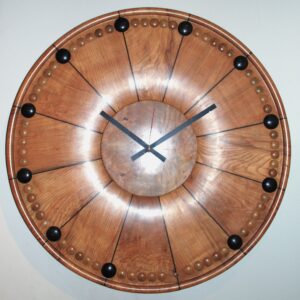

Designed for an exhibition celebrating the City of Leeds Bicentenary at Leeds University. Inspired by the history of retail giant Marks and Spencer who started in Leeds and were a first called the Penny bazaar. Made in Olive Ash, with Ebony, and bleached Ash buttons 900mm diameter.
-
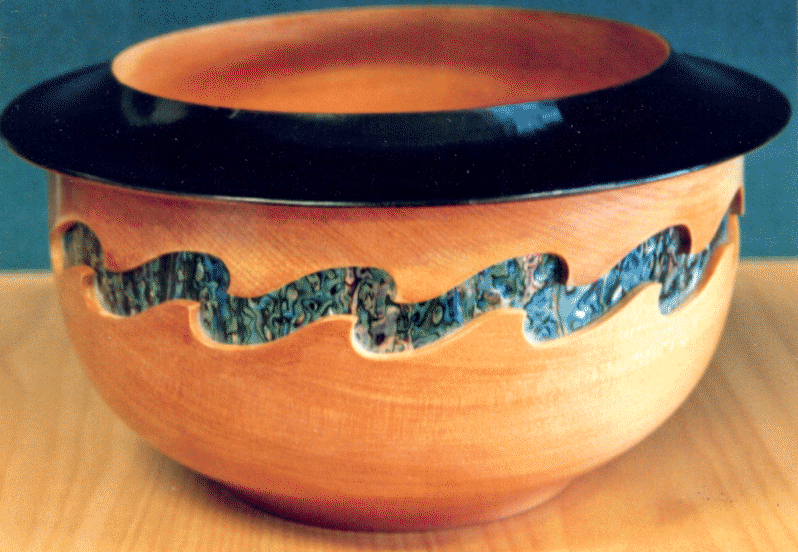
NZ PM. Presentation bowl

Designed for presentation to the New Zealand Prime minister Helen Clark in 2001 for opening of UNITEC school of applied skills. The design was inspired by elements of New Zealand’s environmental history. Turned in Kauri, and inlayed with Paua shell, with a scorched rim.
-

Wood turning
A very small selection of some of the bowls turned over the years. Loads of different timbers, shapes, details, finishes functions from big fruit bowls with natural edges, sculptural forms to small dishes.
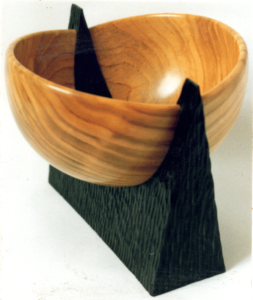

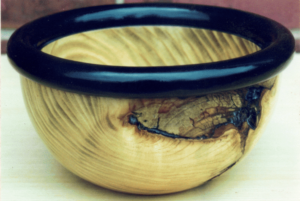
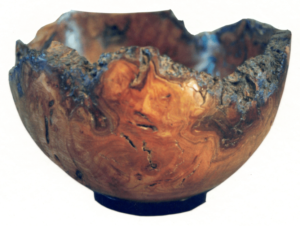
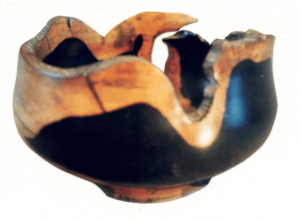

-

Headless Kiwi. P bass Guitar

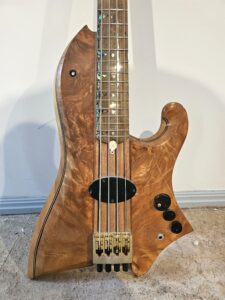
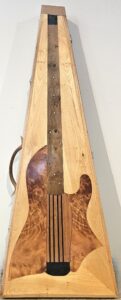
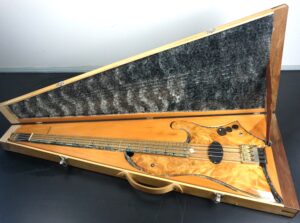
The designs aesthetic is inspired by all aspects of New Zealand and the function formed around ergonomics and balance. The body is derived from the shape of the north and south island and implies the Māori legend of the whale that pulled the land from the sea. The Burr Puriri fretboard is inlayed with Paua as the fret markers in the form of the Koru as a sea motif that slowly transforms through the land and forest into the moon. The body is made in Quartersawn Kauri for the back and 25 thousand year old swamp Kauri on the face this is separated with a Puriri and Tawa pin line. The through neck is made of laminated tapered strips of Taraire and Pohutakawa. The fret markers are lit with LED fiber optic side dots. The volume and tone knobs are Puriri and the tension rod cover is dear Horn found in the Waikarimoana forest. The case is made from Tawa with a fabric lined French fitted interior and a cavity to store bits.
-
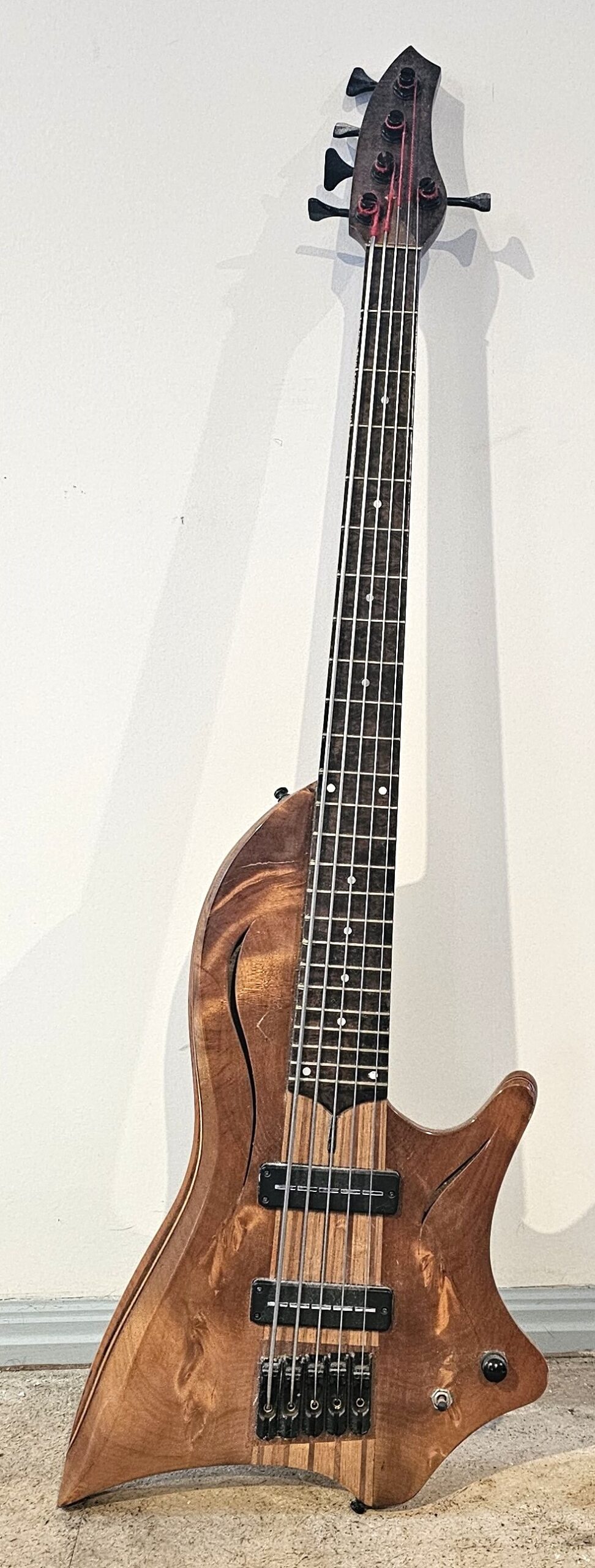
Flying Moa. Bass Guitar
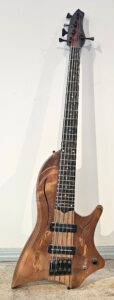

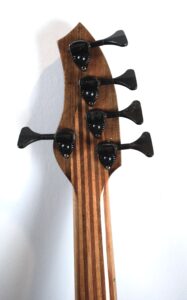
The design and specification was to make a warm sounding bass. Hollow body, through strung, flat wound five string jazz bass. Quartersawn Kauri body with a Swamp Kauri top, the neck is a through neck made from laminated tapered Pohutukawa and Taraire. The Fret board is Burr Puriri with Paua markers. the back has a copper battery cover hiding active pickups.
-
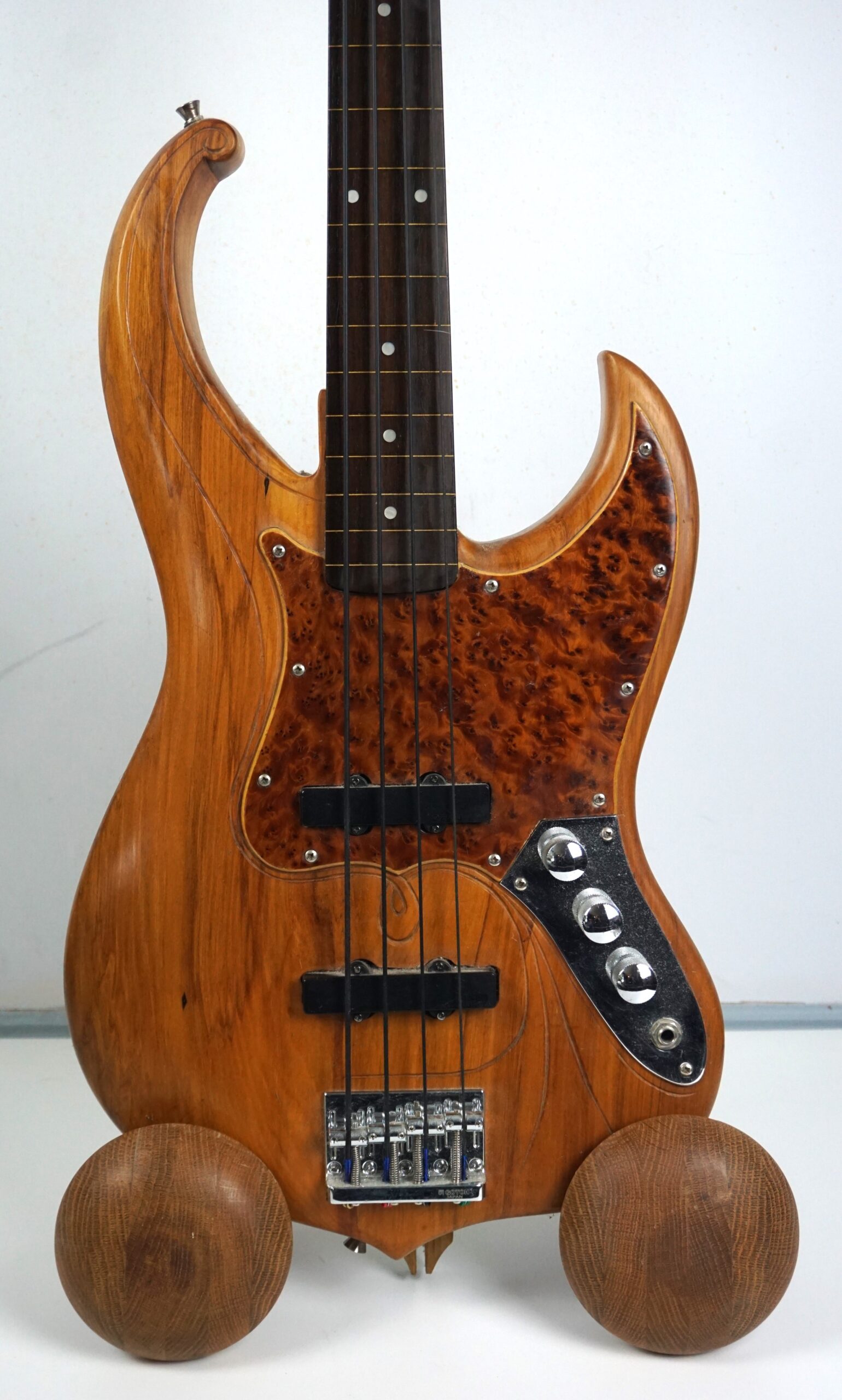
Bass Guitars

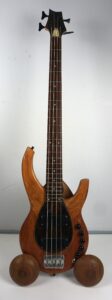
Fretless Jazz. Rimu body with Burr Thuya pick guard.
Active Bass. Totara, Swamp Kauri, Burr Puriri body
-
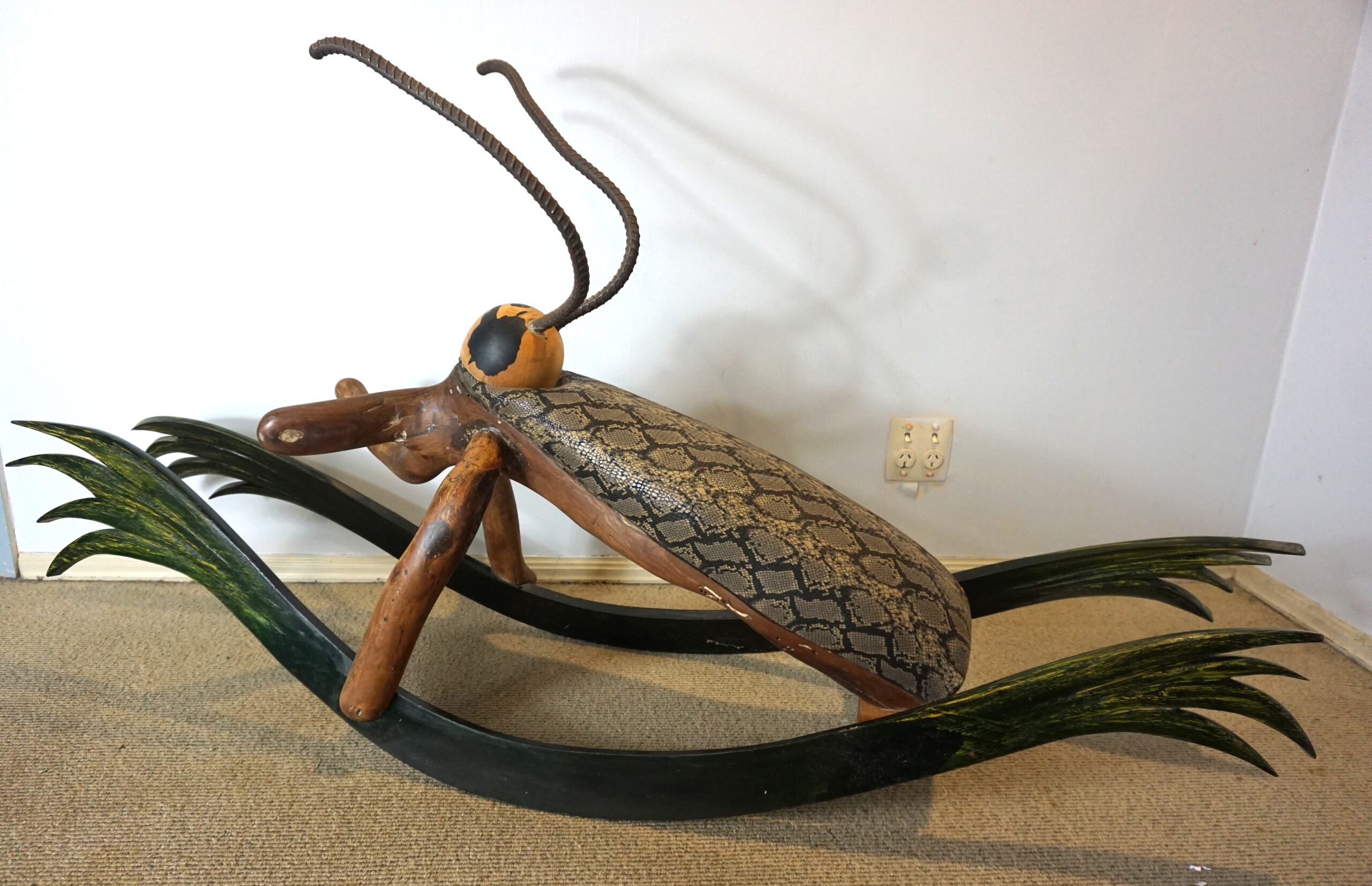
Rocking Weta
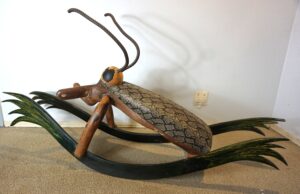
Designed for my sons as a Kiwi alternative to a rocking horse. Made from a Pohutukawa driftwood log, an upholstered snakeskin printed cotton body, a blackwood head and re-bar antennae set on stylised grass rocker.
-
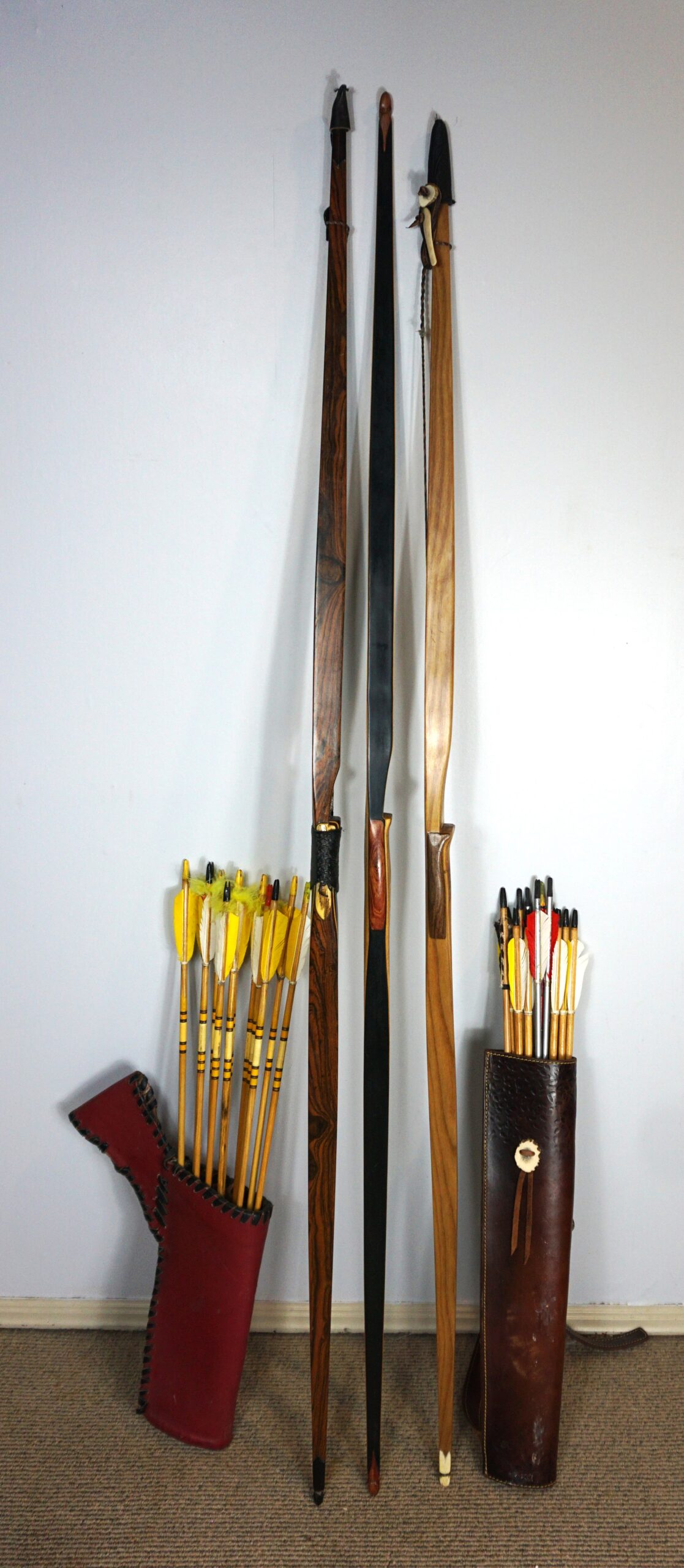
Longbow and arrows

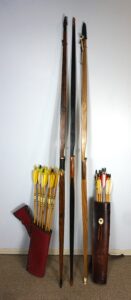



American flat bow. Bamboo core with carbon fibre face and back with and Purpleheart, Oak, Bocote face veneers
Risers
- Puriri, Ebony, Maple/Ebony inlay, horn strike plate.
- Blackwood, Maple, Greenstone strike plate.
- Burr Oak, Walnut, horn strike plate.
